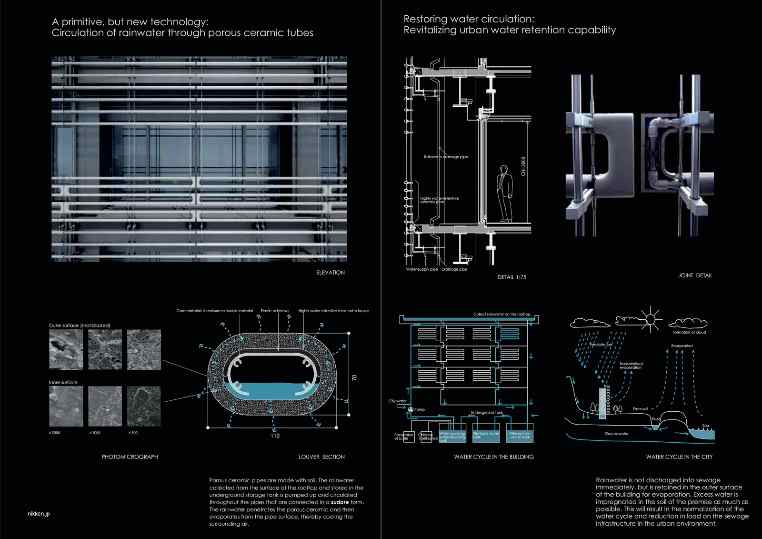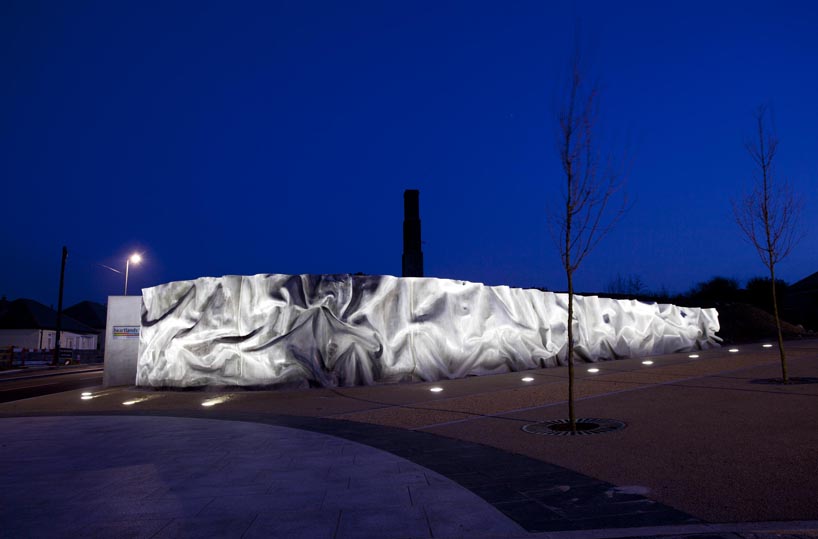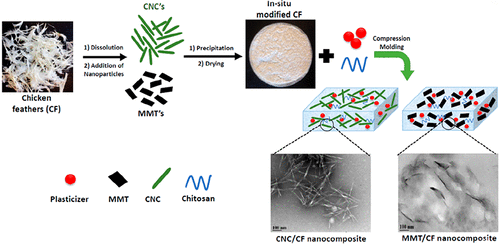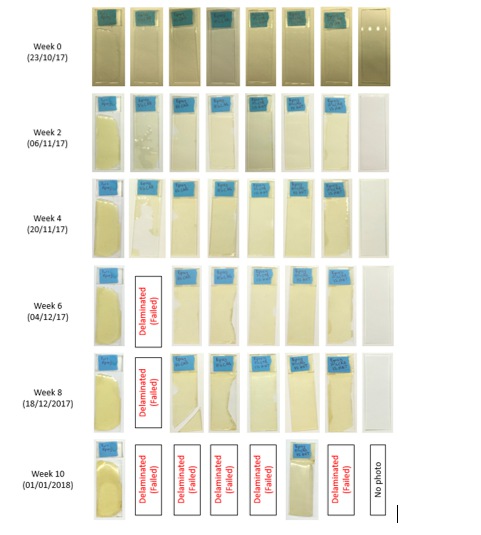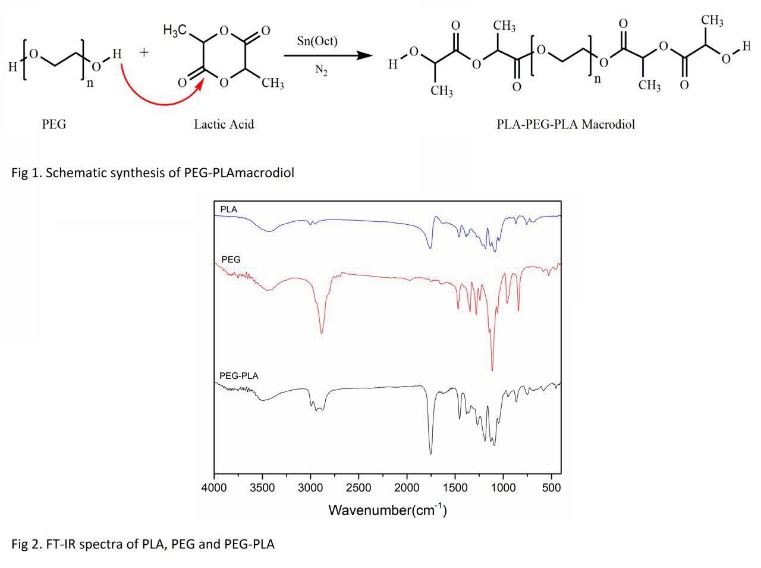Day 1 :
Keynote Forum
Mahmoud Nili-Ahmadabadi
Director at Center of Excellence (COE) for High Performance Materials, Iran
Keynote: On the two way shape memory effect of NiTi/NiTiCu bi-layer composites; experimental and numerical study
Time : 11:40-12:20

Biography:
Mahmoud Nili Ahmadabadi is professor at university of Tehran, is teaching and working on phase transformation of metals and alloys. Different alloys have been the subject of his research, liquid-solid phase transformation, bulk metallic glass or solid-solid phase transformation. In the latter case, shape memory and pseudoelasticity in Fe base or NiTi alloys is one of his recent major research subjects. In the case of NiTi alloys he and his team introduces bi-layer bulk and thin film shape memory NiTi alloys which show intrinsic two way shape memory effect with faster response during loading and unloading.
Abstract:
NiTi/NiTiCu bi-layer composite as a bulk novel material, which shows pseudo-elastic and shape memory properties simultaneously, was made by diffusion bonding method. In addition similar bi-layer but thin film was prepared by deposition onto Si (111) substrates by RF magnetron sputter deposition from separate alloy targets. The interface of bonding of bulk material was investigated by SEM and chemical composition gradient in the interface zone analyzed using line scan analysis with energy dispersive X-ray spectroscopy. In the case of thin film, grazing incidence X-ray diffraction, transmission electron microscopy, electrical resistivity and nano-indentation were used for characterization. An analytical model and FEM study was employed in order to investigating the tensile behavior of composites during loading and subsequent unloading. The solutions of the analytical method are validated with the numerical simulations as well as the experimental results. The chemical and stress gradient in the bi-layers affects the structure, phase transformation and shape memory effect. The bi-layers exhibit multi step phase transformation and intrinsic two-way SME with a reduced hysteresis without complicated training. Considering the results of the analytical modeling, the numerical simulations and the experiments, it is evident that the bi-layer composites with different thickness ratios provide adjustable mechanical behavior that can be considered in different applications design, e.g., actuators, equipped with shape memory components.
Image
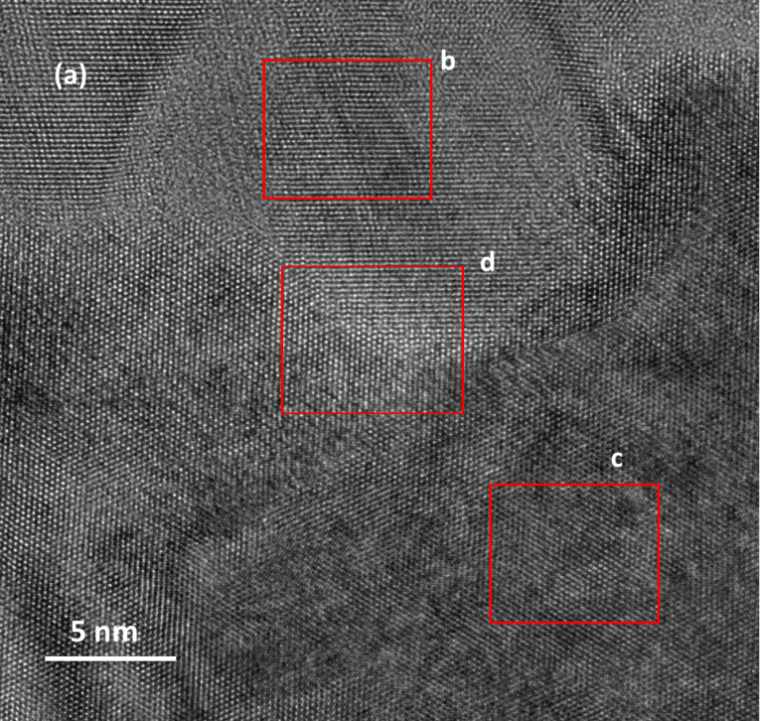
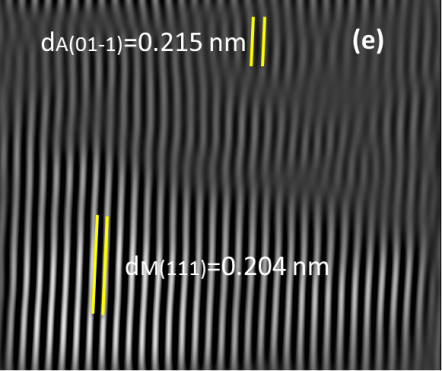
Figure-1: (a) HRTEM image and (e) corresponding inverse FFT image of the interface.
Recent Publication
- Mohri M, Taghizadeh M, Wang D, Hahn H, Nili-Ahmadabadi M (2018) Microstructural study and simulation of intrinsic two-way shape memory behavior of functionally graded Ni-rich/NiTiCu thin film. Materials Characterization; 135: 317-324.
Reference
- Mohri M, Nili-Ahmadabadi M, Pouryazdan Panah M, Hahn H (2016) Evaluation of structure and mechanical properties of Ni-rich NiTi/Kapton composite film. Materials Science and Engineering A; 668: 13-19.
Keynote Forum
Xiaozhong Zhang
Tsinghua University, China
Keynote: Semiconductor Nonlinear Effect Assisted Magnetoresistance and Magnetic Logic
Time : 11:00-11:40

Biography:
Xiaozhong Zhang completed his PhD in1989 from University of Oxford and postdoctoral studies at The Royal Institution of Greast Britain in 1992. Then he worked as a faculty at National University of Singapore for seven years. Since 1999 he has been working as a professor at School of Materails Science and Engineering of Tsinghua University. He is now the deputy director of the Key Laboratory of Advanced Materials, Education Ministry, and is serving as the deputy chief of Chinese national nano-technology standardization committee. He has published more than 190 papers in referred journals and is a co-editor of IUCrJ.
Abstract:
Discovery of giant magnetoresistance (MR) won Nobel Prize in Physics in 2007 and it initiated spintronics. However, most MR devices are based magnetic materials which are not compatible with Si based devices. Coupling semiconductor nonlinear transport effect and Hall effect in semiconductor, we developed a Si-based geometrical enhanced MR device whose room-temperature MR ratio reaching 30% at 0.065 T. We also realized the geometrical enhanced MR in GaAs and Ge. We further coupled semiconductor nonlinear transport effect and anomalous Hall effect in a perpendicular magnetic anisotropic (PMA) material and realized a giant MR of 22000% at 1 mT in PMA material at room temperature. Based on our Si based MR device, we developed a current-controlled reconfigurable MR logic device, which could perform all four basic Boolean logic including AND, OR, NAND and NOR in one device. We proposed an alternative way to realize magnetoelectric logic by coupling spin-dependent transport effect in magnetic material and nonlinear transport effect in semiconductor material. All four basic Boolean logic operations could be performed with high output ratio. We further proposed a magnetic logic-memory device by coupling anomalous Hall Effect in magnetic material and negative differential resistance phenomena in semiconductor. All four basic Boolean logic operations could be programmed by magnetic bit at room temperature with high output ratio (>1000%) and low magnetic field (~5 mT). This device demonstrated that non-volatile information reading, processing and writing could be realized in one step and one device. Hence, logic and non-volatile memory could be closely integrated in one chip. The time and energy used in the processes of information transformation and transfer could be saved. This might break through the von Neumann performance bottleneck and make computer more energy efficiency and higher performance.
Image
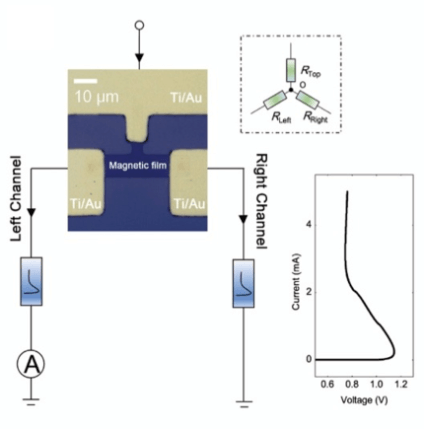
Figure-1: Schematics of our magnetic device structure.
Recent Publications:
1. Luo ZC, et al. (2017) Large magnetoresistance in silicon at room temperature induced by onsite Coulomb interaction, Advanced Electronic Materials, 3:1700186.
2. Rajan R, et al. (2017) Diode and inhomogeneity assisted extremely large magnetoresistance in silicon, Applied Physics Letters 111: 042406.
References
- Luo Z C, et al. (2017) Large magnetoresistance in silicon at room temperature induced by onsite Coulomb interaction. Advanced Electronic Materials; 3: 1700186.
- Rajan, R, et al. (2017) Diode and inhomogeneity assisted extremely large magnetoresistance in silicon. Applied Physics Letters; 111: 042406.
- Wan C H, et al. (2011) Geometrical enhancement of low-field magnetoresistance in silicon. Nature; 477: 304-307.
- Luo Z C, et al. (2017) Reconfigurable magnetic logic combined with non-volatile memory writing. Advanced Materials; 29: 1605027.
- Luo Z C, et al. (2016) Extremely large magnetoresistance at low magnetic field by coupling nonlinear transport effect and anomalous Hall effect. Advanced Materials; 28: 2760–2764.
Keynote Forum
Raafat El-Halcha
University of Calgary, Canada
Keynote: Strengthening/reinforcing concrete structures using shape memory alloy
Time : 10:05-10:45

Biography:
Raafat El-Hacha is then Professor of Structural Engineering at the University of Calgary in the Department of Civil Engineering. He is the member of the International Institute for FRP in Construction (IIFC), American Concrete Institute (ACI), Canadian Society of Civil Engineers (CSCE) and Pre-stressed Concrete Institute (PCI). He is a Fellow member of the IIFC and the CSCE. He is the co-chair of Sub-Committee ACI 440-I “FRP Prestressed Concrete”, and chair of the CSCE Committee on “Advanced Composite Materials for Bridges and Structures”.
Dr. El-Hacha research interest focuses on using high performance advanced materials, such as FRPs, Shape Memory Alloy, Ultra-High Performance Concrete, for hybrid structural systems in bridge applications and other structures. He published over 220 journal and conference papers, co-authored 3 refereed design guidelines. Supervised and graduated 41 students. Served as guest editor for 3 journals, and edited/co-edited 8 conference proceedings. He is the recipient of several distinguished awards and fellowships including the IIFC President’s Award–2016, the CSCE Casimir Gzowski Gold Medal–2014, the Erasmus Mundus International Fellowship–2014 and 2013, the CSCE Excellence in Innovation in Civil Engineering Award–2011, and many others for his outstanding academic and professional experiences and achievements.
Abstract:
Shape memory alloy (SMA) has been attracting the researchers from different fields due to their superior properties. The SMA is a unique class of alloy with the ability to undergo large deformation as well as energy dissipation capacities while maintaining a super-elastic response and return to its original shape through stress removal (super elasticity) or heating (shape memory effect). SMA as internal reinforcement: The superior properties of SMA make it a good reinforcement candidate for the use in the seismic design of structures. The exceptional property of SMA in recovering substantial inelastic deformation upon unloading makes it very beneficial in seismic design. Thus, if SMA is used at the location of plastic hinges with proper design limitations, the structure will dissipate the demand energy and return to its original shape when unloaded. The design of self-centering concrete beam-column connections reinforced using SMA is an innovative proposal and can be optimized for the use in real-life construction. SMA in strengthening applications: Besides the material super-elasticity, corrosion and fatigue resistivity, SMA is mainly characterized by the shape memory effect that represents the ability of the SMA to recover its original shape after being deformed beyond the elastic limits through heating. The strain recovered in this transformation process can be utilized for pre-stressing applications by eliminating the use of hydraulic jacks. By having the pre-strained SMA reinforcement attached to the RC members and then applying heat above the activation temperature the SMA will recover the inelastic strain and thus a pre-stressing force will be developed in the RC member. The pre-strained SMA itself can be used as the pre-stressed reinforcement in flexural strengthening of RC beams as well as active confinement of RC columns.
Recent Publications and References
- Oudah, F., and El-Hacha, R., “Joint Performance in Concrete Beam-Column Connections Reinforced Using SMA Bars” Elsevier Journal of Engineering Structures. Vol. 151, November 2017, PP. 745-760.
- Rojob, H., and El-Hacha, R., “Self-prestressing using Fe-SMA for Flexural Strengthening of RC Beams,” ACI Structural Journal, Vol. 114, Issue 2, pp. 523-532, March-April 2017, 2017
- Rojob, H, and El-Hacha, R., “New Anchorage Mechanism for Smooth Fe-SMA Bar used for Flexural Strengthening of RC Beams using NSM Technique, “Proceedings of the 4th International Conference on Smart Monitoring, Assessment and Rehabilitation of Civil Structures (SMAR 2017), Switzerland, Zurich, 13-15 September 2017, (CD-Rom-8p.)
- Abdelrahman, K., and El-Hacha, R., “Finite Element Modelling of SMA Confined Concrete Columns.” Proceedings of the 4th International Conference on Concrete Repair, Rehabilitation and Retrofitting (ICCRRR 2015), Leipzig, Germany, 05-07 October 2015. 8p.
- Rojob H., and El-Hacha, R., “Flexural Strengthening of RC Beam Using NSM Iron-Based Shape Memory Alloys.” Proceedings of the ICCRRR 2015, Leipzig, Germany, 05-07 October 2015. 8p.
- Materials in Health and Biomedicine | Materials for Energy Storage and Applications | Material Science and Engineering | Market Demand and Value
Location: Dubai, UAE

Chair
Mahmoud Nili Ahmadabadi
University of Tehran, Iran

Co-Chair
Janah Shaya
University de Strasbourg, France
Session Introduction
Aman Ullah
University of Alberta, Canada
Title: Shifting to Biorefinery; Monomers, Biopolymers, Biosorbents and Biomaterials from Renewable Lipid Resources
Time : 12:20-12:50

Biography:
Aman Ullah received his PhD (with distinction) in Chemical Sciences and Technologies in 2010 at the University of Genova, Italy by working together at Southern Methodist University, USA. He worked as a postdoctoral fellow before accepting an Assistant Professor position at the University of Alberta. He has been promoted to Associate Professor with Tenure. He has been teaching a graduate course entitled “Renewable Biomaterials”. This course deals with fundamentals in bio-based materials development, characterization, and various industrial applications. Current research, recent literature, and real-life applications of biomaterials/bionanomaterials in various industries are discussed throughout the course. Aman has published more than 40 papers in reputed journals and 3 patents/patent applications. His research is focused on the development of biochemicals, biopolymers/biomaterials from lipids and other renewable resources. Overall, as PI and Co-investigator, he has attracted a total of ~ $8.7 million in funding in last 5 years. He has participated and presented his work in more than 82 National and international scientific meetings and conferences, including several invited, keynote and plenary lectures at conferences and research centers in Asia, Europe, and America. In addition, he has received several awards including Canadian Rising Star award in Global Health by Grand Challenges Canada in 2012.
Abstract:
In recent years, the use of renewable natural resources have become the focus of research in supplementing and/or replacing traditional petro chemical products due to growing energy demands and environmental concerns. The utilization of lipids and other renewable resources has been considered to play a primitive role towards sustainable development due to their large scale availability, built in functionality, bio degradability and no net carbon dioxide (CO2) production. In addition, a broad range of monomers can be obtained as a single feedstock. These attributes make lipids a good fit for the development of renewable bio materials. This presentation will focus on the conversion of lipids from various sources including waste streams such as waste cooking oil and lipids extracted from spent foul into monomers, bio polymers and bio materials for packaging water remediation, bio medical and other applications. The ability for complete conversion of oils in just few minutes under solvent free conditions into monomers, bio polymers and bio composites/nanocomposites is undoubtedly an attractive concept from both an academic and an industrial point of view.
Image
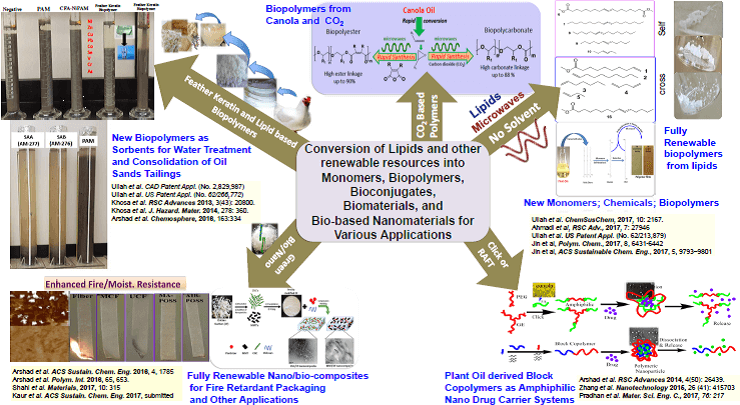
Figure-1: Bio materials from renewable resources.
Recent Publications
- Ahmadi R, Ullah A Microwave-assisted rapid synthesis of a polyether from a plant oil derived monomer and its optimization by Box–Behnken design (2017) RSC Advances; 7: 27946-27959.
- Jin Zeng, Ullah Rapid copolymerization of canola oil derived epoxide monomers with anhydrides and carbon dioxide (CO2) (2017) Polymer Chemistry; 8: 6431-6442.
- Ullah, A.; Arshad, M. Remarkably Efficient Microwave-Assisted Cross-Metathesis of Lipids in Solvent Free Conditions, ChemSusChem, 2017, 10, 2167-2174.
- Jin, L.; Geng, K.; Arshad, M.; Ahmadi, R.; Ullah, A. Synthesis of Fully Biobased Polyesters from Plant Oil, ACS Sustainable Chemistry & Engineering, 2017, 5, 9793–9801
- Kaur, Arshad, Ullah, In-Situ Nanoreinforced Green Bionanomaterials from Natural Keratin and Montmorillonite (MMT)/Cellulose Nanocrystals (CNC), ACS Sustainable Chem. Eng., 2018, 6 (2), pp 1977–1987
Janah Shaya
IPCMS, Strasbourg
Title: Towards High Performance Solvent-free Fluidic Devices
Time : 14:20-14:50

Biography:
Janah Shaya is a postdoctoral fellow and instructor with the CNRS at the IPCMS of Strasbourg (Institut de Physique et Chimie des Matériaux de Strasbourg) in collaboration with Kyushu University, Japan. He joined the IPCMS in October 2016. He got his PhD degree from University of Nice, Sophia Antipolis in France in September 2016 with honor distinction and medal. His work was peer-reviewed and selected for filming for the ACS website at the American chemical society in Philadelphia His principal axes of research are material sciences, biosensors, organic synthesis, photophysics electrochemistry, and applications (energy storage systems and CO2 valorization). He is currently the co-editor of two books on carbon dioxide and cross couplings with interchopen publisher
Abstract:
Solvent-free fluidic optoelectronics constitute a milestone research area that aims at fabrication of ultimate stretchable and flexible devices. The advantages of such non-volatile liquid optoelectronic materials compared to conventional solid-state ones are many i) intrinsic resilience, ii) excellent pore filling ability, iii) solvent-free processing, and iv) possibility to compensate for the degradation (via microfluidic technology), by supplying the device with fresh liquid.
In our lab, we have developed an efficient methodology to confer large aromatic species with a liquid state at room temperature, via functionalization by siloxane chains. A series of emitters and semiconductors and their applications have been executed including their investigations in OLEDs and solar cells. Among the reported results, oligofluorenes led to solvent-free liquid compounds that exhibit both remarkable charge transport properties and strong fluorescence.[3] The materials were found to exhibit ambipolar charge transport properties (hole- and electron-transport) with mobilities of about 10-4 cm2/Vs, i.e. a value comparable to the one of the best solid-state amorphous glasses used in various optoelectronic applications. These components allowed to realize the first distributed feedback (DFB) laser in a monolithic liquid semiconductor, given their high quantum yields (PLQY > 80 %) and extremely low threshold amplified stimulated emission (< 2 ïJ/cm2).
Overall, these results demonstrate that solvent-free liquid organic semiconductors functionalized by siloxane segments can compete in terms of photophysical and charge transport properties with organic glassy semiconductors, thus paving the way for the development of liquid optoelectronic devices.
Further, the optimization of the metal-catalyzed methodologies and the design of the optimal siloxane chains (length, branching, etc.) to synthesize liquid hosts at room temperature are illustrated based on various families such as carbazolebiphenyl derivatives
Image:

Figure. Photograph (at ambient and under UV light) of the strongly luminescent oligofluorene derivative functionalized with short siloxane chains, showing nonvolatile and stable liquid state at room-temperature. Graph (right) showing the temperature dependence of the ambipolar charge transport mobility, with typical recorded ToF signal in the insert.
Recent Publications:
- J.-C. Ribierre, L. Zhao, M. Inoue, P.-O. Schwartz, J.-H. Kim, K. Yoshida, A.S.D. Sandanayaka, H. Nakanotani, L. Mager, S. Méry, C. Adachi, Chem. Commun. 2016, 52, 3103
- J. Shaya, F. Fontaine-Vive, B. Y. Michel, A. Burger, “Rational design of push-pull fluorene dyes: synthesis and structure-photophysics relationship”, Chem. Eur. J. 2016, 22, 10627-10637.
- J. Shaya, M.-A. Deschamps , B. Y. Michel, A. Burger, “Air-stable palladium catalytic systems for sequential one-pot synthesis of challenging unsymmetrical aminated products”, J. Org. Chem. 2016, 81, 7566-7573.
- P.M. Holstein, D. Dailler, J. Vantourout, J. Shaya, A. Millet, O. Baudoin, “Synthesis of Strained γ-Lactams by Palladium(0)-Catalyzed C(sp3)–H Alkenylation and Application to Alkaloid Synthesis”, Angew. Chem. Int. Ed. 2016, 55, 1–6.
- N. P.F. Barthes, B. Y. Michel, J. Shaya, N. Martinet, A. Burger, “Génétique et épigénétique: Un code au-dessus du code”, Journal de la société chimique de France, 2016, 412, 20-27.
Biography:
Janah Shaya is a postdoctoral fellow and instructor with the CNRS at the IPCMS of Strasbourg (Institut de Physique et Chimie des Matériaux de Strasbourg) in collaboration with Kyushu University, Japan. He joined the IPCMS in October 2016. He got his PhD degree from University of Nice, Sophia Antipolis in France in September 2016 with honor distinction and medal. His work was peer-reviewed and selected for filming for the ACS website at the American chemical society in Philadelphia His principal axes of research are material sciences, biosensors, organic synthesis, photophysics electrochemistry, and applications (energy storage systems and CO2 valorization). He is currently the co-editor of two books on carbon dioxide and cross couplings with interchopen publisher
Abstract:
Solvent-free fluidic optoelectronics constitute a milestone research area that aims at fabrication of ultimate stretchable and flexible devices. The advantages of such non-volatile liquid optoelectronic materials compared to conventional solid-state ones are many i) intrinsic resilience, ii) excellent pore filling ability, iii) solvent-free processing, and iv) possibility to compensate for the degradation (via microfluidic technology), by supplying the device with fresh liquid.
In our lab, we have developed an efficient methodology to confer large aromatic species with a liquid state at room temperature, via functionalization by siloxane chains. A series of emitters and semiconductors and their applications have been executed including their investigations in OLEDs and solar cells. Among the reported results, oligofluorenes led to solvent-free liquid compounds that exhibit both remarkable charge transport properties and strong fluorescence.[3] The materials were found to exhibit ambipolar charge transport properties (hole- and electron-transport) with mobilities of about 10-4 cm2/Vs, i.e. a value comparable to the one of the best solid-state amorphous glasses used in various optoelectronic applications. These components allowed to realize the first distributed feedback (DFB) laser in a monolithic liquid semiconductor, given their high quantum yields (PLQY > 80 %) and extremely low threshold amplified stimulated emission (< 2 ïJ/cm2).
Overall, these results demonstrate that solvent-free liquid organic semiconductors functionalized by siloxane segments can compete in terms of photophysical and charge transport properties with organic glassy semiconductors, thus paving the way for the development of liquid optoelectronic devices.
Further, the optimization of the metal-catalyzed methodologies and the design of the optimal siloxane chains (length, branching, etc.) to synthesize liquid hosts at room temperature are illustrated based on various families such as carbazolebiphenyl derivatives
Figure. Photograph (at ambient and under UV light) of the strongly luminescent oligofluorene derivative functionalized with short siloxane chains, showing nonvolatile and stable liquid state at room-temperature. Graph (right) showing the temperature dependence of the ambipolar charge transport mobility, with typical recorded ToF signal in the insert.
Recent Publications (minimum 5)
- J.-C. Ribierre, L. Zhao, M. Inoue, P.-O. Schwartz, J.-H. Kim, K. Yoshida, A.S.D. Sandanayaka, H. Nakanotani, L. Mager, S. Méry, C. Adachi, Chem. Commun. 2016, 52, 3103
- J. Shaya, F. Fontaine-Vive, B. Y. Michel, A. Burger, “Rational design of push-pull fluorene dyes: synthesis and structure-photophysics relationship”, Chem. Eur. J. 2016, 22, 10627-10637.
- J. Shaya, M.-A. Deschamps , B. Y. Michel, A. Burger, “Air-stable palladium catalytic systems for sequential one-pot synthesis of challenging unsymmetrical aminated products”, J. Org. Chem. 2016, 81, 7566-7573.
- P.M. Holstein, D. Dailler, J. Vantourout, J. Shaya, A. Millet, O. Baudoin, “Synthesis of Strained γ-Lactams by Palladium(0)-Catalyzed C(sp3)–H Alkenylation and Application to Alkaloid Synthesis”, Angew. Chem. Int. Ed. 2016, 55, 1–6.
- N. P.F. Barthes, B. Y. Michel, J. Shaya, N. Martinet, A. Burger, “Génétique et épigénétique: Un code au-dessus du code”, Journal de la société chimique de France, 2016, 412, 20-27.
Manoj Gupta
National University of Singapore, Singapore
Title: Corrosion behaviour of Magnesium/Glass microballoon syntactic foams targeting engineering and biomedical applications

Biography:
Manoj Gupta is an Associate Professor at Department of Mechanical Engineering, National University of Singapore. He has been working on lightweight metals (particularly magnesium based materials) over past 25 years. His current research is focused on development of lightweight HEA, ignition resistant magnesium based nanocomposites, magnesium syntactic foams and additive manufacturing (3D printing) of magnesium.
Abstract:
Metal matrix syntactic foams (MMSFs) are a special class of composites in which hollow particles are dispersed through the metal matrix. The presence of hollow reinforcements imparts properties to the composite similar to that would be found in monolithic cellular materials. Such lightweight syntactic foams possessing superior properties are of continuing interest in automotive, aerospace and marine sectors to reduce weight while simultaneously increasing fuel economy required for ever-increasing stricter environmental regulations and stringent service conditions. In this context, magnesium-based materials are emerging strongly primarily due to their low density, combination of better specific strength (σ/ρ), damping characteristics and impact resistance. These properties can still be enhanced by a further reduction in density through the development of magnesium-based syntactic foams. Further, magnesium (Mg) being biocompatible offers huge potential for use as bioresorbable materials for degradable bone replacement implants due to its favorable corrosion and mechanical properties. However, high corrosion kinetics and localized corrosion progress limit wide scale implementation of magnesium based materials in marine environments and clinical implantable devices. This dire requirement necessitated the need for an investigation on corrosion behavior of hollow glass micro-balloon (GMB) reinforced magnesium syntactic foams. As environment of a human body is very aggressive to metallic products, the positive corrosion test results under simulated conditions of a human body provide a good indicator of the corrosion resistance of the material for other applications. This research presents a comparative study of the corrosion of Mg/GMB syntactic foams in Hank’s solution and in 3.5% NaCl solution for a maximum duration of 28 days. The developed syntactic foams were found to reveal promising corrosion behavior along with ~28% reduction in density as compared to pure Mg. The observed increase in corrosion resistance is correlated with intrinsic microstructural changes arising as a consequence of the presence of the hollow GMB particles.
Ray Gibbs
Haydale Limited, United Kingdom
Title: Near term commercial applications for Graphene, Composites and Conductive Pastes

Biography:
Ray Gibbs is a Chartered Accountant and former Deloitte Audit and Corporate Finance Partner for 9 years. He has over 20 years’ experience in high technology and fast moving consumer goods businesses and is a former CFO of Chemring Group Plc. He was part of Haydale Graphene Industries’ management team that acquired Haydale Limited in 2010, became CEO in 2013 and successfully took the business through to IPO in April 2014, defined the strategy and driven for globalization and now sales. He has been immersed into the graphene and nano world for 7 years
Abstract:
The potential for graphene and other nanoparticles to significantly enhance material properties has been well documented. However, as carbon is inert and does not mix well with other materials it needs to be homogeneously dispersed and bonded into the host material in order to realize its potential. There are hundreds of graphenes in the market today and all display different characteristics, from flake size, to thickness and chemical groups on the surface and ends to the supply chain issue in delivery of volume at a commercial cost. Some supply may well require scale up and the likelihood is that the volume output will be different from the pilot plant. Knowing which one material works best and applying a sympathetic surface treatment for a specific application is the Haydale expertise. This functionalization treatment plus the years of processing know how sets Haydale apart in the ability to commercialize nanomaterials. For industry to adopt these new materials we need to demonstrate a repeatable and cost effective supply chain that delivers a masterbatch to the customer. One of the challenges industry faces is that there is currently no standard definition of graphene which means that R&D and general procurement departments may not know exactly what it is they are not buying nor be able to replicate test results with a subsequent batch of material. Industry requires a standardization of materials to remove this uncertainty. The recent ISO paper has helped but there is a way to go. Recent work at Haydale has now confirmed significant improvements in electrical, thermal and mechanical performance of Carbon Fibre pre preg, opening up many applications now. Haydale has significant expertise in GRP and thermoplastic pipes for water, sewerage, and the oil and gas industry. With latter suffering for significant repair issues, leak detection and a desire to replace pipes with non-metallics, the Haydale team has unique solutions for these needs. These breakthroughs plus new pastes for bio medical sensors offers real short term commercial opportunities for grapheme and nanoparticles. The industrial and financial world has been waiting for these commercial applications to bear fruit. Further, in order to persuade industry to adopt the new materials we need to be able to incorporate the functionalized materials into existing production facilities thus avoiding the need for replacement of existing capital equipment. The author will examine these challenges and explain how Haydale has established a consistent supply chain of the nanomaterials and are addressing the commercial adoption challenges through the establishment of Centres of Excellence in strategic locations across the globe in the three dominant continents of The Far East, USA and Europe.
- Synthesis & Characterization | Smarter Lifestyle | Materials for Environmental Applications
Location: Dubai, UAE

Chair
Manoj Gupta
National University of Singapore, Singapore

Co-Chair
Janah Shaya
University de Strasbourg, France
Session Introduction
Lee D Wilson
University of Saskatchewan, Canada
Title: Responsive Biopolymer Materials: A study of their structure and adsorption properties
Time : 14:30-15:00

Biography:
Wilson is affiliated with the Department of Chemistry at the University of Saskatchewan and is an Associate Professor with research interests that cover diverse topics in physical chemistry, materials science and environmental chemistry. Ongoing research activities are focused on the development of new types of materials and studies related to adsorption and interfacial phenomena related to water science and technology. The Wilson research group is developing new forms sustainable biomaterials for the controlled removal of contaminants from water and chemical separations using methods based on green chemistry. This research contributes significantly to technology related to water and energy security that are especially important in various areas of agriculture, natural resources and the environment.
Abstract:
Statement of the Problem: There is a need to develop improved biopolymer adsorbents with responsive properties and enhanced adsorption toward target species for specialized applications in water treatment. In this study, polymer brushes and their iron oxide composites were prepared and characterized, along with the efficacy of methylene blue (MB) removal from aqueous solution. These “smart” materials were designed by grafting biodegradable polymers, poly acrylic acid (PAA) or poly itaconic acid (PIA) onto chitosan to yield pH-responsive polymer brushes of PAAgCHI, PIAgCHI and their magnetic nano composites (MNCs) containing iron oxide, respectively (Fig. 1). The MNCs are pH-sensitive and magnetically responsive adsorbents with switchable polymer morphology between swollen and collapsed states, along with the controlled adsorption and desorption of MB. Switchable MB uptake is based on the pH driven molecular recognition and conformational changes of brushes. The adsorption capacity of the materials varies between 421.2 to 470.2 mg g–1 with a removal efficiency of 99.2% (Fe3O4–PIAgCHI) and 99.5% (Fe3O4–PIAgCHI) for the MNCs. Sorbents can be recovered and efficiently regenerated by switching the pH of solution under an applied external field over five recycle steps. This work illustrates the potential utility of “smart” polymer brush systems for the remediation of model cationic dyes in wastewater. These eco-friendly sorbent materials possess excellent adsorption capacity, modular design, low cost, excellent regeneration, and rapid separation. Potential applications of these materials include the controlled removal of antimicrobials, pesticides, and personal care products from water and wastewater streams with high efficiency and recovery.
Figure 1:
Recent Publications
- Dolatkhah A, Wilson L D (2016) Magnetite/Polymer Brush Nanocomposites with Switchable Uptake Behavior Toward Methylene Blue. ACS Appl. Mater. Interfaces 8 (8): 5595–5607.
- Guo R, Wilson L D (2012) Synthetically Engineered Chitosan-Based Materials and their Sorption Properties with Methylene Blue in Aqueous Solution. J. Colloid Interface Sci. 388: 225–234.
- Casey L S, Wilson L D (2015) Investigation of Chitosan-PVA Composite Films and their Adsorption Properties. Journal of Geoscience and Environment Protection 3(2): 78-84.
- Karoyo, A H, Wilson L D (2016) Investigation of the Adsorption Processes of Fluorocarbon and Hydrocarbon anions at the Solid-Solution Interface of Macromolecular Imprinted Polymer Materials, J. Phys. Chem. C 120 (12): 6553–6568.
- 5. Dolatkhah A, Wilson L D (2018) Salt-Responsive Fe3O4 Nanocomposites and Phase Behavior in Water. Langmuir in press, DOI: 10.1021/acs.langmuir.7b03613.
Ray Gibbs
Haydale Limited, UK
Title: Near term commercial applications for Graphene, Composites and Conductive Pastes
Time : 15:00-16:00

Biography:
Abstract:
Vladimir Nazarov
Research Center for Applied Sciences, Academia Sinica, Taiwan
Title: Cross-over between collective and independent-particle excitations in quasi-2D electron gas with one filled miniband
Time : 16:15-16:45

Biography:
Vladimir Nazarov, (Ph.D.-physics), now is an Associate Research Fellow at the Research Center for Applied Sciences, Academia Sinica, Taiwan. He got his B Sc in physcics, M Sc physics from the Far-Eastern National University, Vladivostok, Russia, and his Ph.D. degree from the Institute for Automation and Control Processes, Far-Eastern Branch of Russian Academy of Sciences, Vladivostok, Russia. Currently Dr. Vladimir Nazarov's researches focus on the fundamentals of Time-Dependent Density-Functional Theory (TDDFT) and its applications to optics and transport in bulk materials and low-dimensional structures. Dr. Vladimir Nazarov has his Habilitation (in Russia, Doctor of Physical and Mathematical Sciences) from the Far-Eastern National University, Russia. The past positions of Dr. Vladimir Nazarov include the Leading Researcher at the Institute for Automation, Far-Eastern Branch of Russian Academy of Sciences, the Associate Professor at Kyushu Institute of Technology, Japan, Visiting Professor at the Institute for Solid State Physics, Japan, and Visiting Professor at Chonnam National University, South Korea.
Abstract:
While it has been recently demonstrated that, for quasi-2D electron gas (Q2DEG) with one filled miniband, the dynamic exchange fx, fx and fh kernels cancel each other in the low-density regime rs tends to infinity (by half and completely, for the spin-neutral and fully spin-polarized cases, respectively) [1], here we analytically show that the same happens at arbitrary densities at short distances. This motivates us to study the confinement dependence of the excitations in Q2DEG. Our calculations unambiguously confirm that, at strong confinements, the time-dependent exact exchange excitation energies approach the single-particle Kohn-Sham ones for the spin-polarized case, while the same, but less pronounced, tendency is observed for spin-neutral Q2DEG [2].
Image:

Fig.1. Time-dependent exact exchange (TDEXX), Kohn-Sham (KS), and Random Phase Approximation (RPA) excitation energies of the fully spin-polarized quasi-2DEG of the density parameter , confined with the strictly 2D uniform positive charge of the density parameter . For better visualization, each point is presented relative to the arithmetic mean of the TDEXX, KS, and RPA values.
Recent publications
1. V. U. Nazarov (2017) Quasi-low-dimensional electron gas with one populated band as a testing ground for time-dependent density-functional theory of mesoscopic systems, Physical Review Letters 118:236802.
2. V. U. Nazarov (2016) Exact exact exchange potential of two- and one-dimensional electron gases beyond the asymptotic limit, Physical Review B 93:195432.
References
1. V. U. Nazarov (2017) Quasi-low-dimensional electron gas with one populated band as a testing ground for time-dependent density-functional theory of mesoscopic systems, Physical Review Letters 118:236802.
2. V. U. Nazarov (2018) Crossover between collective and independent-particle excitations in quasi-2D electron gas with one filled miniband, arXiv:1802.07004 [cond-mat.mes-hall].
Ashok Ganapathy Iyer
Manipal Academy of Higher Education, Dubai
Title: Architectural documentation of heritage buildings in UAE
Time : 16:45-17:15

Biography:
Ashok Ganapathy Iyer is the Chairperson of School of Design & Architecture (SoDA), Manipal Academy of Higher Education Dubai (MAHE-Dubai). He is currently pursuing his PhD Studies at Welsh School of Architecture. His research interests are at the classification of the approaches to learning adopted by students in their design coursework through the five years of the architecture program. He has pursued his Masters in Architectural Studies at Sir J.J College of Architecture, Mumbai, India and Bachelor’s degree from Pillai College of Architecture, Navi Mumbai, India. He was a Faculty at Sir J.J College and Rizvi College of Architecture Mumbai. His other research interests include urban studies and historic architectural developments to construct pattern language, issues of sustainability in contemporary architecture, fine arts and architecture heritage cum documentation
Abstract:
Architectural documentation of heritage buildings in the United Arab Emirates has gained momentum in the past decade with the rapid urbanization of the Emirates including Abu Dhabi, Dubai and Sharjah, UAE. This has been spearheaded through various government departments focusing on architectural conservation of these historic buildings. The school has delved into architectural documentation as a part of the bachelor of architecture program to give students a hands-on insight of the built environment and deconstruct the details into drawings since 2012. As a part of this academic journey, Al Mahatta, the first airport of the Middle-East Region was documented in 2014-15. This documentation led to the consolidated project of preparing a conservation management plan for the museum. This was followed by two projects representing Al Mahatta within the urban fabric of the Emirate of Sharjah as-well-as the neighborhood where it is currently located. This paper delves into the importance of incorporating smart materials in architectural conservation. The paper further delves into the relevance of the technology domain in architectural education and the impact of smart materials of students’ approaches to learning.
Image

Figure: Conservation Management Plan
Recent Publications
- Ashok G Iyer (2015) Review of approaches to learning adopted by architecture students in the coursework of architectural design archi DOCT. The e-Journal for the Dissemination of Doctoral Research in Architecture; 3(1): 21-30.
- Ashok G Iyer & Andrew Roberts (2014) A Phenomenographic Study in Understanding Architecture Students’ Approaches to Learning the Coursework of Architectural Design. Journal for Education in the Built Environment (JEBE); 9(1): 89-109.
References
- AGI “Approaches to Learning in Architectural Design - A Classification,” Abstract No. 65 in RIBA President’s Awards for Research 2017 - Book of Abstracts.
- AGI & Kairmein Deboo, “Archiving an Impression – Al Mahatta and Sharjah,” Conservation Management Plan and Urban Analysis at Al Mahatta Museum, Sharjah, UAE from June 2017 to Jan 2018
- Poster Presentations
Location: Dubai, UAE

Chair
Manoj Gupta
National University of Singapore, Singapore
Session Introduction
Anumol Thomas
Manipal Academy of Higher Education, Dubai
Title: Illusions in architecture

Biography:
Anumol Thomas is currently a 4th year student of B.Arch in Manipal Academy of Higher Education, Dubai, UAE. Her dissertation topic was focused on illusions in architecture, where she studied the different techniques used to create illusions. She has also focused on different smart materials which brought in kinetism such as interactive movements into architecture.
Abstract:
Visual disruptions are the future of modern designs through illusions in architecture. Optical illusions have long been a useful tool for architects. Perhaps most famously, the ancient Greeks used them in the construction of the Parthenon. The interactive movement in architecture through kinetics is also one method to explain about illusions. The motion of small parts together can largely obtain the concept of kinetic architecture. The current lack of extension in the actual movement application in architecture refers to the complexity of the design and the high cost and difficulty of execution; however the evolution in smart materials makes it simpler and easier. The evolution of architecture from static and stability to dynamic and movement has been accompanied by changes in the architectural thought. The interactive material with wind using kinetics has been explained. Inspired by the beauty of grass blowing in the wind, Super Cilia Skin has become the tactile and visual system. An array of computer-controlled actuators (Cilia) is connected to an elastic membrane. These actuators represent data by changing their physical alignment. It has the potential to replay dynamic gestures over time and to communicate remote gestures; this makes it a potentially important tool for tactual communication and education. These cilia move in response to computer-controlled magnetic fields created under the membrane, allowing them to represent information by dynamically changing their physical orientation. The device is designed to sense physical gestures on the cilia and to replay those gestures by fluttering the same cilia that were tapped. On an architectural scale, a facade superimposed with Super Cilia Skin could represent the “wake” of a local wind pattern blowing up and down the surface during the day generating energy. The entire surface of the facade responds to wind via thousands of 9-inch squares of perforated aluminium mounted on low friction hinges. A photographic mosaic of sand dune images is formed from the perforations of the moving panel. Intricate shadow images of the dunes are projected onto the walls and floor of the building lobby, when sunlight passes through the screens. The optical qualities of the skin alter fiercely with the weather and the time of day.
Image
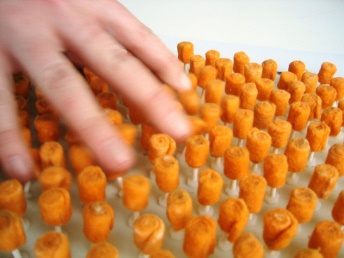
Figure-1: Super cilia skin.
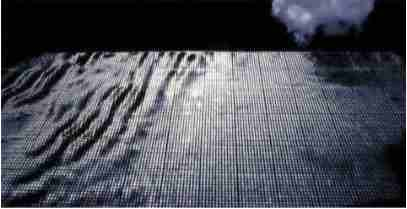
Figure-2: Movement of super cilia skin in a façade.
References
1.Youssef Osama Elkhayat (2014) Interactive movement in kinetic architecture. Journal of Engineering Sciences Assiut University Faculty of Engineering; 42(3): 816-84.
Aishwarya Thomas
Manipal Academy of Higher Education, Dubai
Title: Sustainable campus design in Dubai promoting physical activity within the built environment

Biography:
Aishwarya Thomas is currently a 4th year student of B.Arch program at MAHE, Dubai campus. The mentioned smart technology including a kinetic energy system and pavagen tiling system, has been referred to for use in her undergraduate thesis project which focuses on creating a sustainable campus, reducing levels of inactivity amongst the youth and young adults and the community as a general in the UAE by establishing certain principles of sustainability within the campus and connecting it to the built environment.
Abstract:
Physical inactivity is a major health threat to the global population and in recent years, there has been an increasing body of literature about the fact that the people in Dubai are not getting enough physical activity. According to a disease study report, the obesity rate in the UAE is double the world average more than 2.1 billion people; close to 30 per cent of the global population are overweight or obese, the World Health Organization says. This project plans to research the relationship between physical inactivity and architecture. It is essential that architectural design be re-thought to increase the physical activity levels within the built environment. An alternative approach needs to be looked at, when talking about the design framework and it should definitely focus on convenience without reducing activity with the increase of physical activity levels. A smart approach to achieve this would be a range of considerations to increase the amount of physical behaviors within an individual to produce energy expenditure by individuals in Dubai. The concept of interaction with buildings where change and response could be connected with the physical movement alongside the building is an interesting concept. A kinetic energy system where pedestrian foot fall could be used to power a digital screen so the building can interact with the physical act of walking past could be thought off. It could create a fun and innovative environment that encourages people to enter a space. With potential uses being, passive walker past or even urban street dance competitions or events. Pavegen tiling systems is a tile based urban design feature that captures the kinetic energy from a pedestrian’s footfall and harvests and/or reuses it to power certain off the grid electrical devices. They will be used throughout the design but mainly with relation to an interactive wall. The kinetic energy from foot fall is stored and used to power the LED lights in the wall to create an interactive relationship between the architecture and the physical activity powering it.
Image
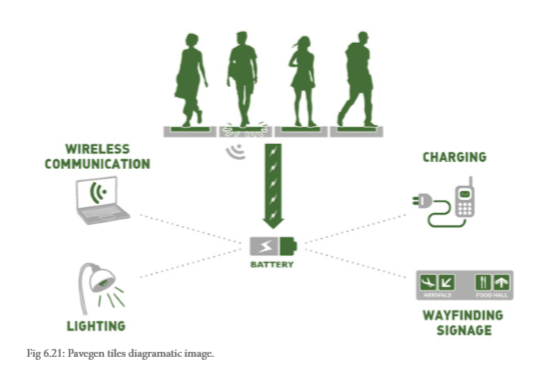
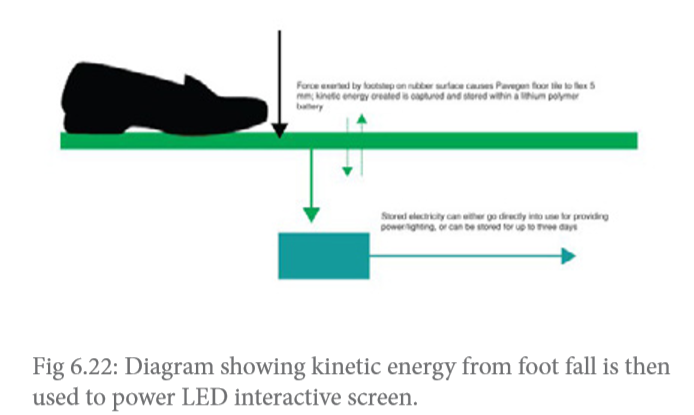
References
1.Cyra, M. (2013). Promoting Physical activity within the built environment
Sundara Vadhana Gurushev
Manipal Academy of Higher Education, Dubai
Title: BioSkin Facades: A reinterpretation of the Mashrabiya

Biography:
Sundara Vadhana Gurushev is currently a 4th year undergraduate student in the B.Arch. program at the School of Design and Architecture at Manipal Academy of Higher Education-Dubai Campus. She is currently working on her design dissertation and thesis on the topic “Archetypes and Identities in Architecture”, that looks at the transition in Emirati Architecture from its vernacular form to the contemporary form. As President of the Conservation and Environment Team at MAHE-Dubai, she has actively been a part of various sustainability initiatives and has led the team to being winners of the Sustainable Campus Initiative by the Environment Agency of Abu Dhabi. She is also a part of the UNGC Local Network as a Youth Ambassador.
Abstract:
Archetype, in Jungian theory, is a primitive mental image inherited from the earliest human ancestors and supposed to be present in the collective unconscious. Identity refers to one’s unique façade, so to speak, in this case, a country’s history or culture. Vernacular Architecture is referred to as ‘Architecture of the People’. It becomes a language of form and culture which gives rise to identities unique to its context. Architectural identities, however, do not necessarily mean monuments or magnificent structures. The architectural identity of a region can be found in the most basic houses of the region. This study focuses on the vernacular design elements that can be reinterpreted and adapted into present day architecture of the gulf. Sudare, the famous Japanese bamboo blinds and Uchimizu, a Japanese air-cooling technique that uses water-spray to cool the surroundings. These were the foundations of the BioSkin Facade system, developed by Nikken Sekkei for the Sony Tower in Osaka back in 2011. The reinterpretation of two ancient techniques by infusing them with existing technology, won the company the CTBUH 2014 award for Innovation. The system uses ceramic pipes which have rainwater harvested on the rooftop running through them. These pipes are exposed to the heat of the buildings surroundings which lets the water evaporate, thus, cooling the immediate surroundings. This second skin facade of Sony Tower reduces its cooling load while also eliminating Urban Heat Island Effect. The concept is similar to that of a Mashrabiya found in the gulf region. The Mashrabiya in olden times was an intricately carved screen that sometimes had a pot of water that cooled the hot air passing through the screen. Applying a similar concept to the gulf region, the BioSkin Facades could be applied in this region as well. Although the system uses rainwater, something that is not found in the gulf; the water could instead be replaced with grey water, which is found globally and can be sourced from the building itself. This would mean the existence of a second skin system that can be adapted and used globally, even in regions where rainwater harvesting is not feasible.
Image
References
1. Oliver, P. (2014). Built to Meet Needs.
2. Yamanashi, T. &. (2011). BIO SKIN urban cooling facade. Architectural Design.
3. Fathy, H. (1989). Natural Energy and Vernacular Architecture: Principles and Examples with Reference to Hot Arid Climates. United Nations University.
Saigeethalakshmi
Manipal Academy of Higher Education, Dubai
Title: Industrial architecture through a textile factory

Biography:
Saigeethalakshmi is a student of Manipal Academy of Higher Education, U.A.E. Her current thesis project focusses on designing a textile factory which will show the industrial architecture and the concept of the free flowing concrete texture on the building façade. The probable conclusion that would come in the future is to challenge and show that factory, industrial architecture and design also has to narrate its own story.
Abstract:
When we think of factories or any industrial buildings, beauty’s usually not the first thing to come to mind, but apparently think of dirt, mud, toxic waste, impurity contamination, dim and dull box like warehouse structures with no sunlight entry inside. But this is not the truth. Factory buildings repeatedly offer a chance for architects to experiment with form, materiality, and structural techniques. Beauty in industrial architecture conveys various factors including exterior design, interior functionality, environmental efficiency and landscape layout. All of them have to narrate their story.
The product named “Crushed wall” is the latest architectural installation designed by British artist Walter Jack (Pic: 1 & 2) which tells how the texture and the form of textiles can be used to create architecture. This material is designed at the entrance of the heartlands project in Cornwall, UK, the expansive 40-metre long, 3-metre high wall utilizes concrete in such a way that it appears as soft and malleable, partially wrapping around the perimeter of a building.
The product being concrete has tried to reflect the fluidity of textile. Material used is Bardon Cemflow A, a free flowing, self-compacting mix of concrete of an architectural grade, used for finishes, a sheet of rubber and plywood. Concrete isn’t known for its tactile qualities also not noted for its fluid softness. And yet it is a liquid. The challenge of this concrete material is to retain continuity of the fluid form of concrete and mirror it with the textile texture accuracy to ensure continuity of form. Benefits of the material: Reduced labour requirements and lower site noise levels, flexible placing options and reductions of placing and finishing time and improved output in precast environments.
Images
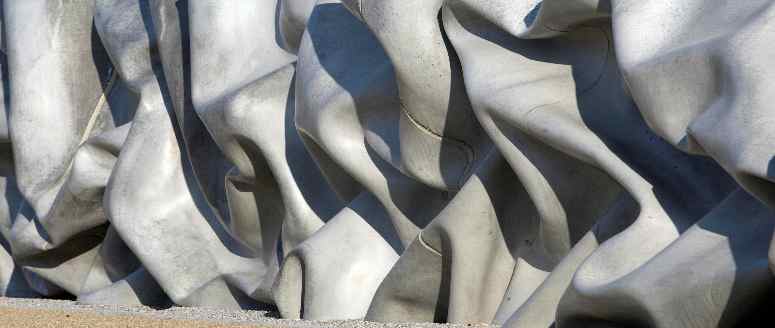
References
|
[1] |
"AGGREGATE INDUSTRIES," March 2014. [Online]. Available: https://www.aggregate.com/sites/aiuk/files/atoms/files/aggregate-industries-concrete-ready-mix-cemflow-tds.pdf. |
|
[2] |
"BARDON CONCRETE," August 2011. [Online]. Available: https://www.barbourproductsearch.info/Bardon-Concrete-brochure-2011v-file030891.pdf. |
|
[3] |
"designboom," 2016. [Online]. Available: https://www.designboom.com/art/walter-jack-studio-crushed-wall/. |
|
[4] |
"AGGREGATE INDUSTRIES," 2016. [Online]. Available: https://www.aggregate.com/sites/aiuk/files/atoms/files/concrete_commitment_brochure_4.pdf. |
Christy Paul Joseph
Manipal Academy of Higher Education, Dubai
Title: Eco-Panelling: Parametric solutions for façade configurations

Biography:
Christy Paul Joseph is a student currently enrolled in the 4th Year of the Bachelors in Architecture (B.Arch) Program in MAHE Manipal, Dubai Campus, UAE. His research largely revolves around the interpretative planning and schematic implementation of a design that echoes the character of a renowned genius, Leonardo Da Vinci. The design aims at complementing the tropical climate in its site of inception, while incorporating parametric façade skins that envelope the organic framework while generating a daylit illuminance in the exhibition space.
Abstract:
Eco-Panelling is about the development of building envelope solutions for tropical humid climates involving passive control of thermal gains on their surfaces, allowing for better internal conditions and thermal comfort without the use of thermal machine. Environmental principles, design and technological aspects are specifically defined based on the peculiar conditions (ego climatic, technological of biodiversity and economic) present in the Middle Eastern low altitude regions, marked by constant high temperatures. Thermal and CFD simulations orient the process of experimental verification through parametric design. Within the design component presented here; different stages of development can be defined. It involves a wide literature review and the analysis of various façade configurations, placing emphasis on those solutions of a local nature and responding to the climatic conditions of the particular case of interest i.e. hot and humid climates. A number of designs were compiled and 3D modelled for the purple of analysis. Following that, a general structure was proposed guided by 3 main determining factors: functional, technological and environmental. Each group had specific factors and was translated into design possibilities but the changing parameters, their relative values and simulation based evaluations producing a conceptual parametric structure. Having defined and developed the parametric design structure the final stage looks for a particular implementation of such model where the generic values given to materials nad design technologies will be replaced by commercially available, low embedded and energy components that showed high performance levels in pre evaluations of their environmental and functional behaviour.
Image:
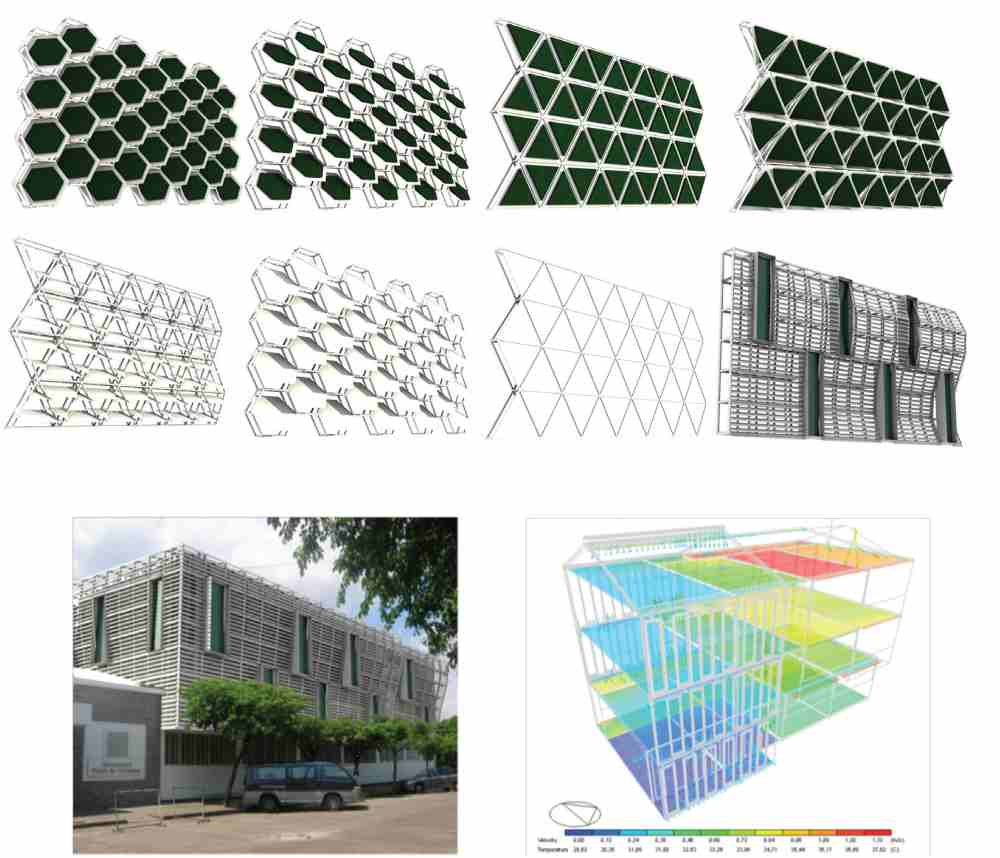
Figure : Examples of geometrical configurations produced from the parametric definition, and CFD analysis of an application to the selected building, half with the original cladding, half with a generated system using non coplanar elements in clay. The simulation for the 21st of June (hottest day) indicates a 4ºC temp. difference in favour of the generated solution. (Hausladen, 2008)
References
1. Walter Isaacson. (2017). Leonardo Da Vinci. New Orleans: Simon & Schuster.
2. Hausladen, G 2008, ClimateSkin: Building-skin-Concepts that Can Do More with Less Energy, Birkhäuser, Munich
3. Leighton, M & Bader, S 2010, ‘Responsive shading - Intelligent façade systems’, Proceedings of the 30th annual conference of the Association of Computer Aided Design in Architecture ACADIA, New York,. pp. 263-269
- Property Changing Smart Materials | Smart Materials & Structures | Materials in Industry | Emerging Materials | Nano Smart Materials | Future of Materials
Location: Dubai, UAE

Chair
Hamayun Khan
Islamia College University, Pakistan

Co-Chair
Janah Shaya
University de Strasbourg, France
Session Introduction
Ahmed S. Razeen
Cairo University, Egypt
Title: Effect of Ag-doping on the properties of ZnO thin films for UV stimulated emission
Time : 10:20-10:50

Biography:
Ahmed S. Razeen is a teaching assistant at the National Institute of Laser Enhanced Sciences (NILES), Cairo University. He finished his MSc. researches in thin film fabrication, focusing on the stimulated emission properties of ZnO thin films. He is interested in fabrication and characterization of new optical materials.
Abstract:
Ag doped ZnO thin films has been prepared using sol-gel spin coating method, with different doping concentrations. Structural and morphological properties of the films have been investigated by X-ray diffraction (XRD) and scanning electron microscopy (SEM) techniques. Thin films have been optically pumped and stimulated emission has been observed with strong peaks in the UV region. The UV stimulated emission is found to be due to exciton-exciton scattering, and Ag doping promoted this process by increasing the excitons concentrations in the ZnO lattice. Output-input intensity relation and peak emission, FWHM, and quantum efficiency relations with pump intensity have been reported. The threshold for which stimulated emission started has been evaluated to be about 18 MW/cm2 with quantum efficiency of about 58.7%. The role of Ag in enhancement of stimulated emission from ZnO thin films has been investigated.
Image:
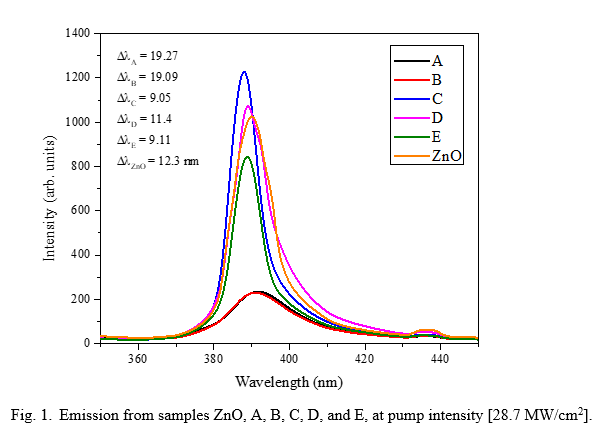
Recent Publications:
- Ahmed S. Razeen, A.-S. Gadallah, and M. M. El-Nahass, “Ultraviolet Stimulated Emission from Sol-Gel Spin Coated ZnO Thin Films,” Advances in Materials Science and Engineering, vol. 2017, Article ID 9464862, 7 pages, 2017. doi:10.1155/2017/9464862.
Zoran Eres
Rudjer Boskovic Institute, Croatia
Title: Simultaneous Synthesis of Single-layer and Multi-layer Graphene
Time : 11:05-11:35

Biography:
Zoran Eres has completed his MSc from Faculty of Electrical Engineering and Computing. He is working as an Expert Advisor at Rudjer Boskovic Institute, Zagreb, Croatia. He is currently a PhD student. He is the author of 1 patent, 9 conference papers and 10 official studies. He was Leader of project “High temperature cell for optical measurements in corrosive atmosphere” completed in 2015
Abstract:
Single-layer graphene (SLG) and multi-layer graphene (MLG) are synthesized in single batch using vacuum-assisted chemical vapor deposition (VA-CVD) process. Copper foil substrate is used as catalyst for SLG synthesis and nickel foil substrate is used as catalyst for MLG synthesis. Substrates are placed in VA-CVD reactor tube, copper substrate positioned as first and nickel as second relative to gas inlet port. Substrates are annealed in hydrogen atmosphere at 1273 K for 60 minutes. Methane gas is used as carbon atom source with growth time of 30 minutes. Cooling rate is critical variable in MLG synthesis-flash cooling resulted in no MLG deposits while cooling rates of 5 K/minute resulted in good MLG deposits. Raman spectrums of SLG samples indicate low concentration of defects and thickness of one graphene layer. Raman spectrum of MLG indicate medium to high concentration of defects and multiple graphene layers. This method can substantially reduce amount of man-hours if one needs to synthesize both SLG and MLG.
Image:
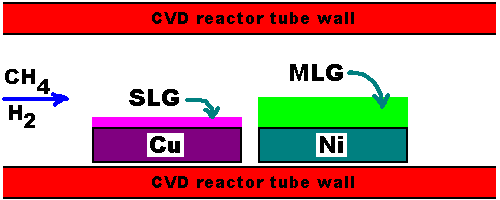
Recent Publications:
- Z. Eres, S. Hrabar, Low-cost multi-layer graphene for linear/non-linear metasurface applications, 2016 10th International Congress on Advanced Electromagnetic Materials in Microwaves and Optics, METAMATERIALS 2016,7746463, pp. 136-137
- Z. Eres, S. Hrabar, Graphene for metamaterials: Synthesis using do-it-yourself low-cost reactor, 2015 9th International Congress on Advanced Electromagnetic Materials in Microwaves and Optics, METAMATERIALS 2015,7342473, pp. 421-423
Hamayun Khan
Islamia College University, Pakistan
Title: Polypyrrol/MnO2 composites: Synthesis, characterization and analytical applications
Time : 11:35-12:05

Biography:
Hamayun Khan has completed his PhD in Chemistry/Chemical Engineering from Kyungpook National University, Republic of Korea. Currently, he is working as an Associate Professor, Department of Chemistry, Islamia College University, Pakistan and taught Analytical Chemistry as major subject. His fields of interests are environmental and bio analytical chemistry, material chemistry, separation science and technology, wastewater treatment, resource recycling and waste management. He has published one Korea patent, one chapter in book and more than 50 papers in reputed journals. He has served as the Director Academics and ORIC of Islamia College University, Peshawar, Pakistan.
Abstract:
Synthesis, characterization and analytical applications of polypyrrole (PPy)-MnO2 composites is presented herein. PPy and its composites were synthesized in the aqueous medium by a modified chemical oxidation polymerization method using ferric chloride as an oxidant. The materials were characterized by FT-IR, XRD, TGA, UV-visible, SEM and EDX spectroscopic and analytical techniques. The FT-IR results confirmed the successful synthesis of PPy and PPy/MnO2 composites with amorphous and crystalline structures, respectively and enhanced thermal stability in case of composites. The SEM and EDX data showed the porous nature of the materials with desired elemental composition. The BET surface area was also determined and found to be increases with the increase of MnO2 content in the composites. The UV-visible spectral analysis confirmed the doping of PPy in composites and found the decrease in the energy band gap values with the increase of MnO2 content in the composites. The analytical applications such as electrical and gas sensing of the synthesized materials were also determined using LCR-meter. The results showed the semiconducting behavior of the materials where the resistance is dependent on temperature and MnO2 content of the composites. The gas sensing behavior of the materials showed high selectivity and sensitivity towards NH3 using 1 to 30 ppm concentration with 0.4 ppm LOD at 25 oC. The sensitivity, response and recovery times of the materials were also determined.
Image
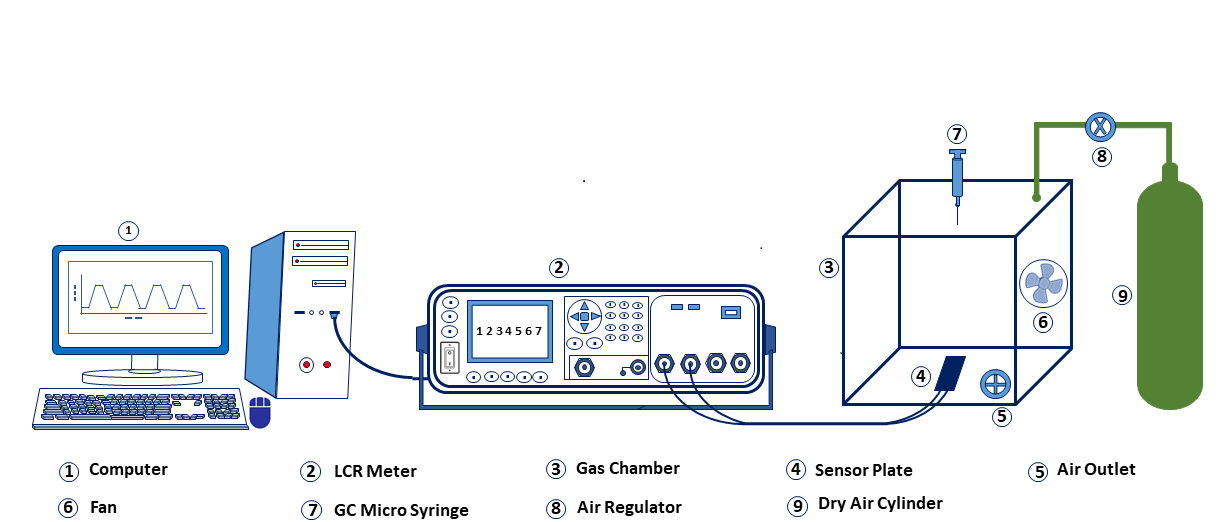
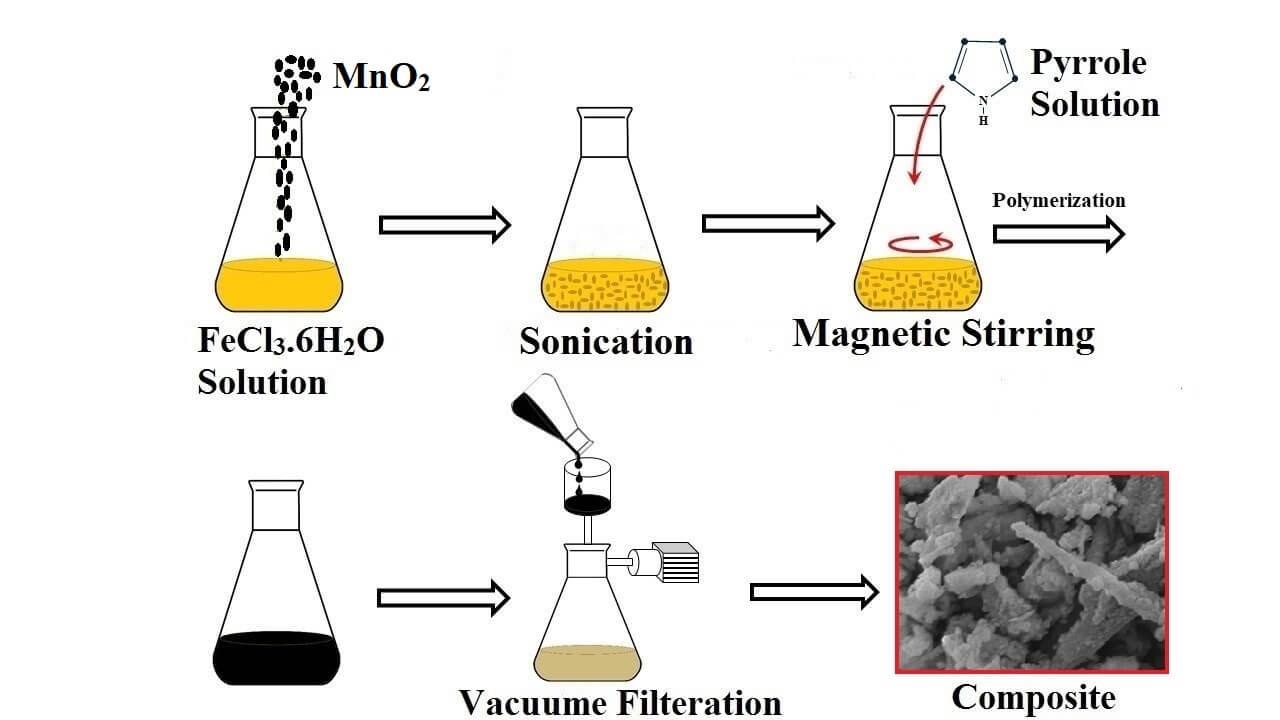
Figure-1: Schematic presentation of the synthesis, characterization and analytical applications of PPy/MnO2 composites
Recent Publications
1. Ali N, Ismail M, Khan A, Khan H, Haider S, Kamal T (2018) Spectrophotometric determination of urea in real samples using silver nanoparticles by standard addition and 2nd order derivative methods. Spectrochimica Acta Part A: Molecular and Biomolecular Spectroscopy; 189: 110-115.
2. Malook K, Khan H, Shah M, Ihsan-Ul-Haque (2018) Synthesis, characterization and electrical properties of polypyrrole/V2O5 composites. Korean Journal Chemical Engineering 35(1): 12-19.
References
1. Zhang A Q, Xiao Y H, Lu L Z, Wang L Z, Li F (2013) Polypyrrole/MnO2 composites and their enhanced electrochemical capacitance. J. Appl. Polym. Sci.; 130: 1327-1331.
2. Ramesan M T (2013) Synthesis, characterization, and conductivity studies of polypyrrole/copper sulfide nanocomposites, J. Appl. Polym. Sci.; 128: 1540-1546.
3. Yang X, Li L, Zhao Y (2010) Ag/AgCl-decorated polypyrrole nanotubes and their sensory properties. Synth. Met.; 160: 1822-1825
Hiroshi Asanuma
Chiba University, Japan
Title: Novel Applications of Smart Materials and Structures Aiming at Disaster Mitigation
Time : 12:05-13:05

Biography:
Hiroshi Asanuma has been developing the field of smart materials/structures and related technologies for many years by proposing new concepts and demonstrating them, which include such as metal-based smart composites (fiber reinforced metals capable of fiber-matrix sliding for secondary forming, healing, etc., optical fiber embedded aluminum etc. as structural materials having robust sensing function, metal-core piezoelectric fiber embedded aluminum etc. as structural materials having robust sensing/actuating/energy harvesting functions, active laminates having variety of functions such as actuating/sensing/repairing, and so on. After the serious earthquake and tsunami disasters in Japan in 2011, he started to apply smart materials/structures including his variety of robust materials, and has proposed the novel concept of “Disaster Mitigation and Sustainable Engineering” with his colleagues, which intends to enable sustainability as well as disaster mitigation, effectively and economically. He has developed a research committee, organized workshops/conference sessions, delivered plenary/keynote/invited presentations and seminars to establish the new world.
Abstract:
The author et al. have proposed to use novel materials/technologies such as smart materials/structures and related technologies to enable revolutionary prevention/mitigation of disasters. The deployable breakwater shown in Figure 1 is an example, which can be used daily for energy harvesting, small enough not to become an obstacle, and a smart breakwater deployable by force and material of tsunami etc.1) The author et al. discussed new approaches which enable sustainability as well as disaster mitigation, and named it “Disaster Mitigation and Sustainable Engineering.” Then the author developed a committee in JSME M&P division. In this presentation, smart disaster mitigation strategies especially based on smart materials/structures are described. To realize the concept, two elemental researches, i.e. artificial forest and novel deployable structure based on honeycomb are examined.1) The researches below are also undergoing by the author and/or his collaborators. (i) Applications of piezoelectric polymers in electrical power generation using ocean waves (Su). (ii) Dynamic deployment of smart inflatable tsunami airbags (Shahinpoor).2) (iii) A novel underwater inflatable structures for smart costal disaster mitigation (Adachi). (iv) SHM of pipelines for environment pollution mitigation (Felli et al.).3) (v) The contribution of LARES to global climate change studies (Sindoni et al.).4) (vi) Smart disaster mitigation in Italy (Felli et al).5) (vii) Smart disaster mitigation in Thailand (Aimmanee et al.).6) In addition, Kubo, Tanaka, Maruyama and Asanuma started to develop a multi-layered deployable structural material system to dissipate wave energy by separating water flow and letting them collide. Challenges have been also done in industries and some are commercialized. Especially, neo RiSe flap-gate type seawall (Hitachi Zosen), SHELCAR (STARLITE Co., Ltd.), MOSE Project and Aqua Dam are attractive. Takenaka Corporation proposed innovative “Breakwater and breakwater group.” Toward future, Disaster Mitigation and Sustainable Engineering has to be brushed up to smartly overcome or rather utilize disasters.
Figure 1:
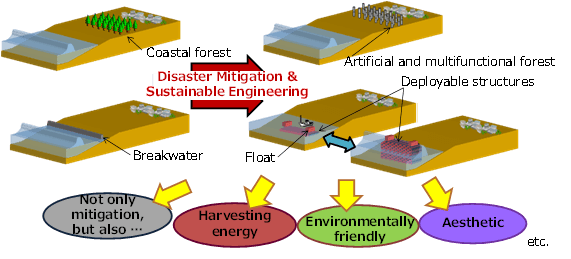
Typical examples to show the concept of “Disaster Mitigation and Sustainable Engineering.”
Recent Publications
- Asanuma H, et al. (2016) Disaster mitigation based on smart structures/materials. SPIE Vol. 9803, Paper No. 980302-1: 1-12.
- Shahinpoor M, Asanuma H (2015) Dynamic deployment of smart inflatable tsunami airbags (TABS) for tsunami disaster mitigation. Proc. ASME SMASIS2015, Paper No. 2015-8904: 1-4.
- Felli F, et al. (2015) Structural health monitoring of pipelines for environment pollution mitigation. Proc. ASME SMASIS2015, Paper No. 2015-8922: 1-7.
- Sindoni G, et al. (2015) The contribution of LARES to global climate change studies with geodetic satellites. Proc. ASME SMASIS2015, Paper No. 2015-8924: 1-7.
5. Felli F, et al. (2014) Smart disaster mitigation in Italy, Proc. ASME SMASIS2014, Paper No. 2014-7631, 1-8.
- Bioactive Smart Materials | Shape Changing Smart Materials
Location: Dubai, UAE

Chair
Hamayun Khan
Islamia College University, Pakistan

Co-Chair
Janah Shaya
University de Strasbourg, France
Session Introduction
Aman Ullah
University of Alberta, Canada
Title: Amphiphilic polymeric nanoparticles for drug delivery
Time : 16:35-16:50

Biography:
Aman Ullah has received his PhD in Chemical Sciences and Technologies in 2010 at the University of Genova, Italy by working together at Southern Methodist University, USA. He worked as a postdoctoral fellow before accepting an Assistant Professor position at the University of Alberta. He has been promoted to Associate Professor with Tenure. He has been teaching a graduate course entitled “Renewable Biomaterials”. He has published more than 40 papers in reputed journals and three patents/patent applications. His research is focused on the development of biochemicals, biopolymers/biomaterials from lipids and other renewable resources.
Abstract:
Amphiphilic block copolymers and ABA type PEG-Lipid conjugated macromolecules have been synthesized using microwave-assisted reversible addition-fragmentation chain transfer (RAFT) polymerization and the copper-catalyzed azide-alkyne cycloaddition commonly termed as “click chemistry”, respectively. Characterization of the block copolymers and conjugates has been carried out with the help of 1H-NMR, FTIR and GPC. These copolymers and conjugates were evaluated for the encapsulation and release of drug. Carbamazepine, an anticonvulsant drug with poor water solubility was selected to be a hydrophobic drug model in the study. The micellization, drug encapsulation and release behavior of macromolecules was investigated by dynamic light scattering (DLS), transmission electron microscope (TEM) and fluorescence spectroscopy. From the results, it has been concluded that the nanoparticles had different average sizes due to different ratio of hydrophilic contents in the block or conjugate backbone. The particle size and structure could be altered by changing the ratio of hydrophilic and hydrophobic contents. The in vitro drug encapsulations highlighted that all the drug-loaded micelles had spherical or near-spherical morphology. In vitro drug release study showed the controlled release of hydrophobic drug over a period of max. 70 hours. The results indicate that there is great potential of renewable lipid-based micelle nanoparticles to be used as hydrophobic drug carriers.
Recent Publications
- Arshad M, Pradhan RA, Ullah A (2017) Synthesis of lipid-based amphiphilic block copolymer and its evaluation as nano drug carrier. Mater. Sci. Eng. C.; 76: 217-223.
- Zhang S, Arshad M, Ullah ​​A (2015) Drug encapsulation and release behavior of telechelic nanoparticles. Nanotechnology; 26: 415703.
References
- Fang et al. (2013) Nanostructured lipid carriers (NLCs) for drug delivery and targeting. Recent Pat Nanotechnol; 7(1): 41-55.
- Nishiyama et al. (2006) Current state, achievements, and future prospects of polymeric micelles as nanocarriers for drug and gene delivery. Pharmacol Ther.; 112(3): 630-48.
Arun M. Umarji
Indian Institute of Science, India
Title: Aluminium quenched Brownmillerite type SrCoO2.5 for oxygen enrichment
Time : 15:35-16:05

Biography:
Following his Ph. D. from IIT, Madras in 1980, Prof. A. M. Umarji held post-doctoral positions at IIT Madras, Argonne National Laboratory, USA and at TIFR in Mumbai. He has been a faculty member of the Materials Research Centre since 1987. He was a visiting faculty member (1997-98) at the Ceramics and Materials Eng. Department, Rutgers University, Piscataway, NJ- USA.
Abstract:
Ternary oxides are known for many applications like solid oxide fuel cells, catalysis, gas sensing etc [1]. These oxides can be oxygen non-stoichiometric if transition metals with variable oxidation states are present. This can be regarded as a functionality if the extent of oxygen vacancies inside the lattice is very high. They can transport oxygen through the lattice when a partial pressure gradient of oxygen is applied. This is normally exploited in case of Oxygen separation membranes [1]. Perovskite oxides (general formula ABO3) are promising candidates as they can exist in a variety of oxygen non-stoichiometric forms with varying temperature and oxygen partial pressure. SrCoO3 (Perovskite, Pm m) is one of such material which reversibly transforms to SrCoO2.5 (Brownmillerite, Ima2) phase at 350°C [2]. Here in we report the application of Brownmillerite SrCoO2.5 for oxygen enrichment.
Brownmillerite (BM) SrCoOx phase has been stabilized to date only by liquid nitrogen quenching [3]. We report a novel and cost-effective method of quenching for the synthesis of the BM SrCoOx. T. Dasgupta et al. [4]reported a quenching method using Al foil pads to control oxygen stoichiometry of REBaCo2O5+d. Herein, we extend this method to stabilize the BM phase of SrCoO2.5. The solution combustion synthesized powder was calcined and sintered at 1223 K in pellet form. This pellet was quenched to 473 K using Al foil pads to stabilize the intact ceramic with Brownmillerite phase. A simple home-built volumetric setup has been fabricated for studying the Oxygen storage property of the material [5]. The sample was pre-treated with a higher partial pressure of oxygen at 673 K to form the oxygen-rich perovskite phase and this phase was heated at lower pressure to study the desorption characteristics. The pressure change observed when sample releases oxygen is used to find the oxygen storage capacity. Desorption characteristics of the sample treated at varying oxygen partial pressure have been studied. The results indicate 14.72 litres/kg of oxygen can be stored in the sample at STP.
Image

Recent Publications
[1] J. Sunarso, S.S. Hashim, N. Zhu, W. Zhou, Perovskite oxides applications in high temperature oxygen separation, solid oxide fuel cell and membrane reactor: A review, Prog. Energy Combust. Sci. 61 (2017) 57–77. doi:10.1016/j.pecs.2017.03.003.
[2] H. Jeen, W.S. Choi, M.D. Biegalski, C.M. Folkman, I.-C. Tung, D.D. Fong, J.W. Freeland, D. Shin, H. Ohta, M.F. Chisholm, H.N. Lee, Reversible redox reactions in an epitaxially stabilized SrCoOx oxygen sponge., Nat. Mater. 12 (2013) 1057–63. doi:10.1038/nmat3736.
References:
[1] Y. Takeda, R. Kanno, T. Takada, O. Yamamoto, M. Takano, Y. Bando, Phase Relation and Oxygen-non-stoichiometry of Perovskite- like Compound SrCoOx (2.29 < x < 2.80), Z. Anorg. Allg. Chem. 541 (1986) 259–270.
[2] T. Dasgupta, S. Sumithra, Arun M. Umarji, A novel method to control oxygen stoichiometry and thermoelectric properties in (RE)BaCo2O5+δ, Bull. Mater. Sci. 31 (2008) 859–862.
[3] Aswathy M. Narayanan, Rajasekar P., Arun M. Umarji, Stabilization of Brownmillerite type SrCoO2.5 by a Costeffective Quenching method for Oxygen Scavenging Applications, Submitt. to Ind. Eng. Chem. Res. (2018).
Santanu Mandal
Carborundum Universal Limited, India
Title: Smart Materials – A Quantum Jump in Technological Advancement
Time : 14:05-15:05

Biography:
Dr. Santanu Mandal joined Carborundum Universal Limited (CUMI) right after accomplishment of Ph.D. Thesis Programme at CSIR – CG&CRI in 2001. In 1994, he did his graduation in Chemical Technology with specialization in Ceramic Engineering & M.Tech. in Ceramic Engineering from University of Calcutta in 1996. In CUMI, Dr. Santanu has been working in R&D and Technology function at various capacity & right now is leading a fine young Team of Research & Development (DSIR approved IRD Unit) of Carborundum Universal Limited, Ceramic division which is dealing with wear resistance & technical ceramic products for industrial & advanced applications. Recently, as an additional responsibility he is leading the Technology and R&D of Wendt (India) Limited which is dealing with CBN & Diamond-based Super Abrasive Products.
The key responsibilities are (a) New Business Development through “Ideation to Launching” of New Products in line with CUMI’s strategic intent through In-house R&D or Technology Cooperation/absorption, (b) New Technology, Product & Process Development (c) R&D Process & Product Portfolio Management.
Innovation Awards:
- Chairman Innovation Award (in CUFEST - 2010) for the Development of Zero-expansion Reaction-Sintered Aluminium Titanate Ceramics
- Chairman Innovation Award (in CUFEST 2014) for the Development of high-strength sub-micron grade Alumina Ceramics for Thin-film Metallized Substrate & other Advanced Applications
- Chairman Innovation Award (in CUFEST 2015) for the Development of Thermal Grade of Zirconia Products for Ferrous Handling & other Thermal Applications
Publications/Patents:
- Published 33 Papers in International/National Journal and Proceedings
- Granted/Filed 18 Patents in India
Abstract:
Whether the extension of Le Chatelier’s principle applies to human being and materials? It does apply to human being and hence it ranks right at the top in the hierarchy of smartness/intelligence. The human being can process data, convert into information, develop knowledge, gains wisdom and applies it.
Can it be engineered to develop smart/intelligent materials so that it respond to external stimulus and changes its response with the help of change in bonding, crystal structure and microstructure? There are certain materials which are inherent smart/intelligent, whereas there are materials need to be induced to generate smartness/intelligence. The former group of materials can be coined as ‘Inherent Smart’ materials whereas the latter can be called as ‘induced smart’ materials. For example, structural smartness behaviour under stress can be induced on monoclinic zirconia through partial stabilization with appropriate amount of Y2O3 dopant whereas functional smartness can be induced to conduct oxygen ions with the same Y2O3 dopant at different proportion. Again, the increase in strength with increasing temperature for certain class of materials like dense Al2TiO5, SiC ceramics can be the example of inherent smart ceramics. In sintered Al2TiO5 such behaviour arises due to the presence of micro-fissures. The micro-fissures forms due to thermal hysteresis loop during heating & cooling because of thermal expansion anisotropy in its pseudobrookite crystal structure. Likewise, self-healing materials/composites, self-cleaning glass are the examples of inherent smart materials. In case of functional materials, usually sensors are induced smart materials whereas transducers are inherent smart materials. The presentation will be dealt with many examples of smart materials along with scientific explanation & related applications. This new class of smart materials is believed to contribute quantum jump in human comfort & happiness as well as in economic progress.
Image:
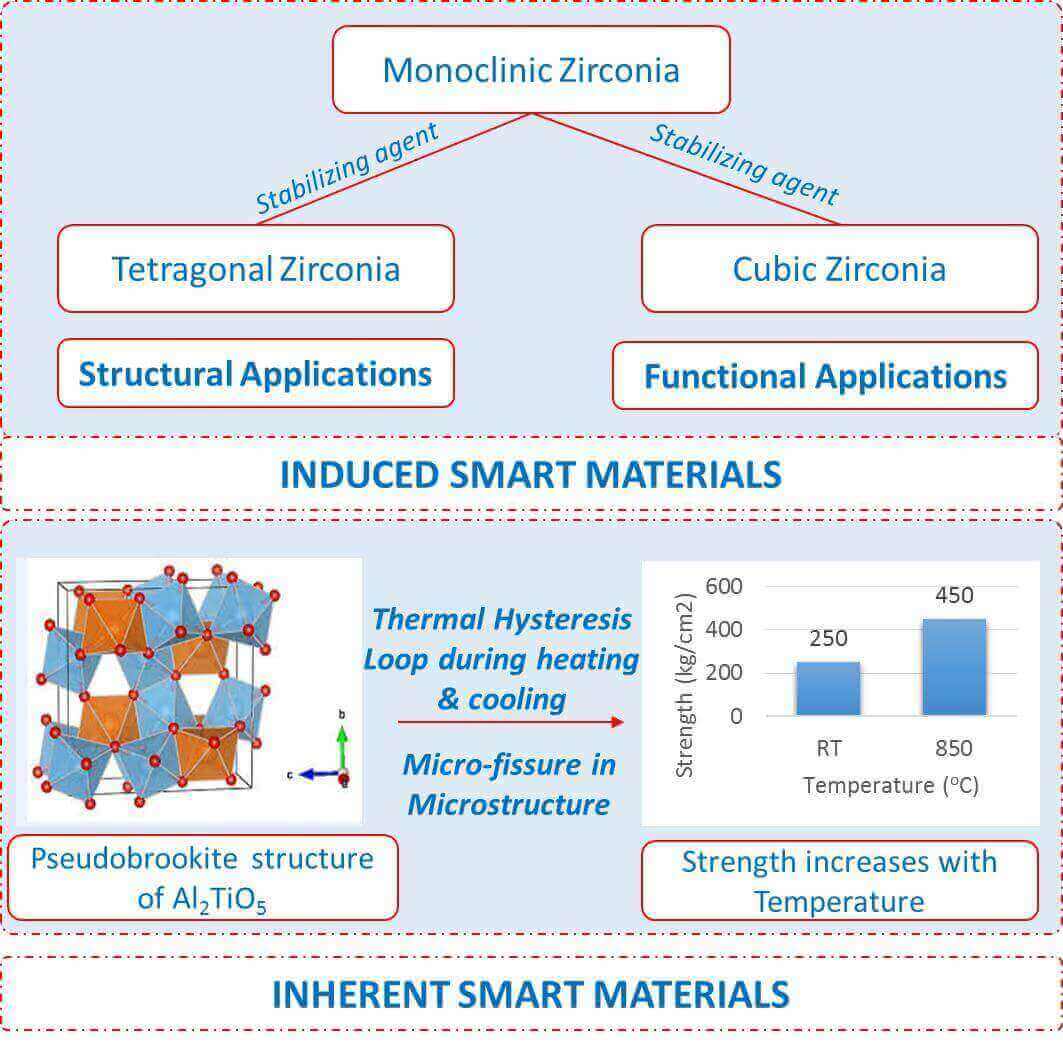
Recent Publications:
- Takagi, T. et al, (1990). “A concept of intelligent materials”. J. Intell. Mater. Syst. Struct., 1: 149-156.
- Kessler et al., (2003). "Self-healing structural composite materials". Composites Part A: Applied Science and Manufacturing. 34 (8): 743–753.
- S.E. Prasad et al., (1995). "Ceramic Sensors and Actuators for Smart Structures". Robotics and Knowledge Based Systems Workshop, Canadian Space Agency.
- Rewadee Wongmaneerung et al., (2009). “Potential of Nanocomposite Technique for Fabrication of Smart Ceramics”. Chiang Mai J. Sci. 36(2) : 179-187
- “Smart Materials and Structures: New Research” Book by Peter L. Reece (2006)
Vladimir U Nazarov
Academia Sinica, Taiwan
Title: Electron energy-loss spectroscopy of quasi-2D crystals: Beyond the energy-loss functions formalism
Time : 16:20-16:35

Biography:
Vladimir U Nazarov is currently the Associate Research Fellow at the Research Center for Applied Sciences, Academia Sinica, Taiwan. He has received his BSc and MSc in Physics from the Far-Eastern National University, Vladivostok, Russia and his PhD degree from the Institute for Automation and Control Processes, Far-Eastern Branch of Russian Academy of Sciences, Vladivostok, Russia.
Abstract:
Inelastic scattering of the medium-energy (~10-100 eV) electrons underlies the method of the high-resolution electron energy-loss spectroscopy (HREELS), which has been successfully used for decades to characterize pure and adsorbate-covered surfaces of solids. With the emergence of graphene and other quasi-two-dimensional (Q2D) crystals, HREELS could be expected to become a major experimental tool to study this class of materials. We, however, identify a critical flaw in the theoretical picture of the HREELS of Q2D crystals in the context of the inelastic scattering only (“energy-loss functions” formalism), in contrast to its justifiable use for bulk solids and surfaces. The shortcoming is the neglect of the elastic scattering, which we show is inseparable from the inelastic one and which, affecting the spectra dramatically, must be taken into account for the meaningful interpretation of the experiment. With this motivation, we build a theory of the simultaneous inelastic and elastic electron scattering at Q2D crystals. We apply this theory to HREELS of graphene, revealing an important effect of the strongly coupled excitation of the π+σ plasmon and elastic scattering resonances. Our results open a path to the consistent and interpretable study of the elementary excitations in crystalline mesoscopic materials by means of HREELS, with its supreme resolution on the meV energy-scale, which is far beyond the capacity of the now overwhelmingly, used EELS in transmission electron microscope.
Recent publications
- V U Nazarov (2017) Quasi-low-dimensional electron gas with one populated band as a testing ground for time-dependent density-functional theory of mesoscopic systems. Physical Review Letters; 118: 236802.
- V U Nazarov (2016) Exact exchange potential of two- and one-dimensional electron gases beyond the asymptotic limit. Physical Review B; 93: 195432.
References
- V. U. Nazarov, E. E. Krasovskii, and V. M. Silkin (2013),Scattering resonances in two-dimensional crystals with application to graphene. Phys. Rev. B 87:041405(R).
- V. U. Nazarov, V. M. Silkin, E. E. Krasovskii (2017) Probing mesoscopic crystals with electrons: One-step simultaneous inelastic and elastic scattering theory, Phys. Rev. B 96: 235414.
Nazrin Abdullayeva
TOBB University of Economics and Technology, Turkey
Title: Copper-Indium-Sulfide Based Flexible Electrodes for Solar Water Splitting
Time : 15:05-15:35

Biography:
Nazrin Abdullayeva is currently a PhD. student in the Materials Science and Nanotechnology Engineering Department at the TOBB University of Economics and Technology (TOBB ETU), Ankara, Turkey. She has graduated from the Department of Chemical Engineering of Hacettepe University, Ankara, Turkey in 2015. She has received her Master degree in Materials Science and Nanotechnology Engineering from TOBB University of Economics and Technology (TOBB ETU), Ankara, Turkey in 2017. Nazrin has carried out researches in the field of conductive polymers and ionomers, photovoltaic devices, semiconductor materials and thin film solar cell applications.
Abstract:
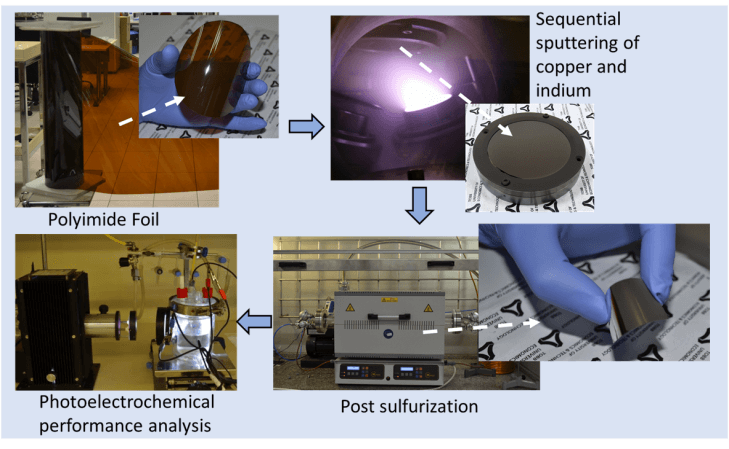
Janah Shaya
Université de Strasbourg, France
Title: Economic syntheses of push-pull fluorene probes using air-stable Pd catalytic systems: Applications into imaging of lipid membranes

Biography:
Janah Shaya is a Postdoctoral Fellow and Instructor with the CNRS at the IPCMS of Strasbourg in collaboration with Kyushu University, Japan. He has received his PhD degree from University of Nice Sophia Antipolis in France in September 2016. He is currently the Co-Editor of two books on carbon dioxide and cross couplings with Intech Open publisher.
Abstract:
Extensive research continues to find catalytic methods and straightforward syntheses for biological and environmental applications. In particular, the architecture of new fluorescent tools is of huge demand. Push-pull dyes exhibiting the two-photon absorption (2PA) property are of particular interest. These dyes are highly responsive to changes of environment. They constitute useful biosensors and probes for specific detections of nucleic acids. They also enable imaging and penetration into cells with reduced photo-damage. Our work presents: 1) Step-economic and concise approaches to a spectrum of push-pull fluorene dyes: As an example, a planned route involved one-pot synthesis installing both the electron-donor and acceptor. Another route comprised selective formylation followed by C-N cross coupling via air-stable palladium catalytic systems, 2) Photo-physical characterization and structure-property relationships of a library of 20 synthesized fluorene compounds and 3) Application of an optimized solvatochromic fluorene probe to imaging lipid organization in cell membranes. The presented fluorene dye outperforms the features of popular probes like Laurdan. Some of the established improvements are: red-shifted absorption that matches the 405 nm diode laser, higher brightness decreasing the used concentration for such staining by 20 folds, remarkable photo-stability, compatibility with two-photon excitation at wavelength more than 800 nm, among others.
Figure-1: Graphical abstract.
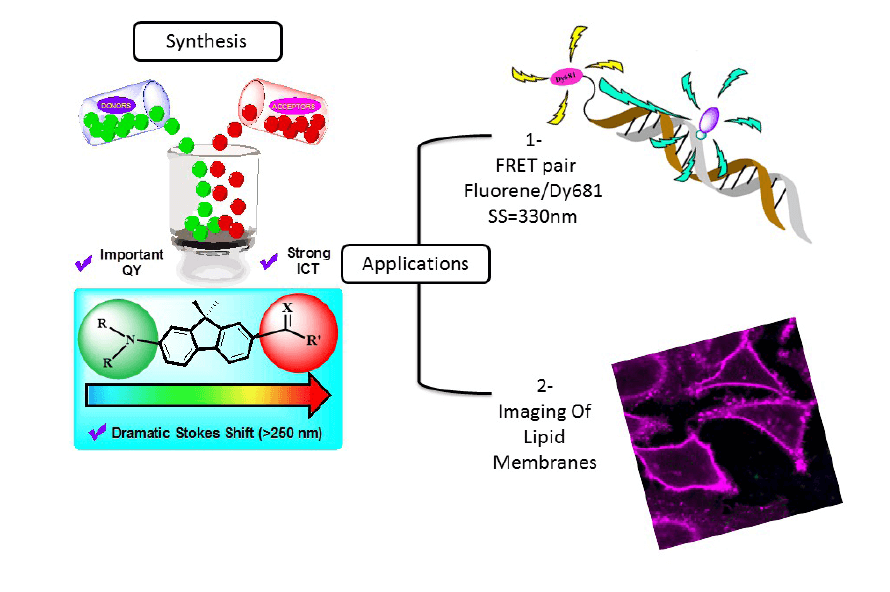
Recent Publications
1. P M Holstein, D Dailler, J Vantourout, J Shaya, A Millet, O Baudoin (2016) Synthesis of Strained γ-Lactams by Palladium(0)-Catalyzed C(sp3)–H Alkenylation and Application to Alkaloid Synthesis. Angew. Chem. Int. Ed.; 55: 1–6.
2. J Shaya, F Fontaine-Vive, B Y Michel, A Burger (2016) Rational design of push-pull fluorene dyes: synthesis and structure-photophysics relationship. Chem. Eur. J.; 22: 10627-10637.
References:
1. J. Shaya, F. Fontaine-Vive, B. Y. Michel, A. Burger, “Rational design of push-pull fluorene dyes: synthesis and structure-photophysics relationship”, Chem. Eur. J. 2016, 22, 10627-10637.
2. J. Shaya, M. A. Deschamps, B. Y. Michel, A. Burger, “Air-stable palladium catalytic systems for sequential one-pot synthesis of challenging unsymmetrical aminated products”, J. Org. Chem. 2016, 81, 7566-7573.
3. J. Shaya, M. Collot, F. Bénailly, N. Mahmoud, Y. Mély, B. Y. Michel, A. S. Klymchenko, A. Burger, “Turn-On Fluorene Push-Pull Probes with High Brightness and Photostability for Visualizing the Different Liquid Domains of Cell Membranes”, ACS Chemical Biology, 2016, 12, 3022-3030.
4. S. Huang, C. Chen, H. Tsai, J. Shaya, C. Lu, “Photocatalytic degradation of thiobencarb by a visible light-driven MoS2 photocatalyst”, Separation and Purification Technology, 2018, 197, 147-155
- Poster Presentations
Location: Dubai, UAE

Chair
Santanu Mandal
Carborundum Universal Limited, India
Session Introduction
Arun M Umarji
Indian Institute of Science, India
Title: Fabrication of device quality VO2 thin films

Biography:
Arun M Umarji had pursued his PhD from IIT and held Postdoctoral positions at Argonne National Laboratory, USA and at TIFR in Mumbai. He has been a Faculty Member of the Materials Research Centre since 1987. He was a Visiting Faculty Member at the Ceramics and Materials Engineering Department, Rutgers University, USA.
Abstract:
Semiconductor to metal transition (SMT) in metal oxide is the most fascinating field of research in materials science. This transition can be triggered by thermal, electrical, strain, etc. where oxides show a drastic change in resistivity. Large number of oxides are known to show this kind of transition but VO2 shows this transition near to room temperature (TSMT ~68 ºC). It undergoes a change in crystal structure from monoclinic phase (M1, P21/c) to tetragonal phase (R, P42/mnm). Due to this phase transition it has been used for various applications like smart windows, metamaterial, bolometers, etc. Herein, we report the synthesis of device quality VO2 thin films. Various methods like home-built Ultrasonic Nebulized Spray Pyrolysis of Aqueous Combustion Mixture (UNSPACM), Chemical Vapor Deposition (CVD), Pulsed Laser Deposition (PLD) and DC Reactive sputtering have been employed to synthesize the thin films. The structural characterization of the thins films have been carried out by XRD and Raman measurements which confirms the M1 phase of VO2 at room temperature followed by high temperature measurements to study the phase change to R phase. A temperature dependent resistance measurement confirms the SMT transition at 68 ºC with a three-four order of magnitude change in resistance. Temperature dependent IR measurements show ~80% change in reflectance across the phase transition where the thin film acts as an IR reflector (T>TSMT). Effect of substrate, synthesis process, post-annealing on SMT have been studied.
Image
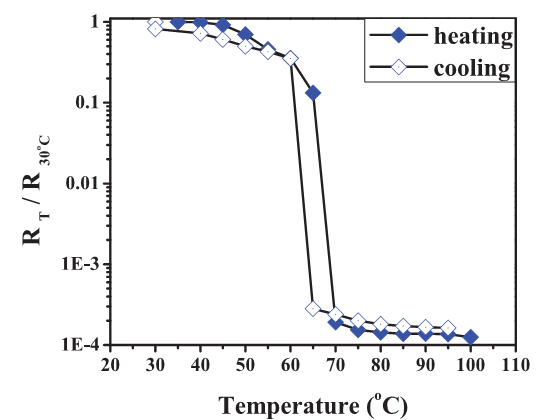
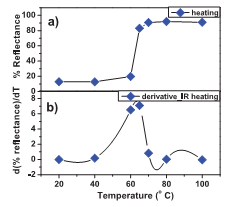
Figure-1: Left figure shows the change in resistance and right shows the change in reflectance as a function of temperature for VO2 thin films synthesized using UNSPACM.
Recent Publications
- R Bharathi, A M Umarji, et al. (2017) Thermochromic VO2 thin films on ITO-coated glass substrates for broadband high absorption at infra-red frequencies. Journal of Applied Physics; 122(16): 163107.
- Pradhan J K, A M Umarji, et al. (2017) High contrast switchability of VO2 based metamaterial absorbers with ITO ground plane. Optics Express; 25(8): 9116-9121.
References
- Yang Z, C Ko and S Ramanathan (2011) Oxide Electronics Utilizing Ultrafast Metal Insulator Transitions. Annual Review of Materials Research; 41(1): 337-367.
- Good enough J B (1971) The two components of the crystallographic transition in VO2. Journal of Solid State Chemistry; 3(4): 490-500.
Manoj Gupta
National University of Singapore, Singapore
Title: Evolution of lightweight high entropy alloys for weight critical applications

Biography:
Manoj Gupta is a former Head of Materials Division of the Mechanical Engineering Department and Director designate of Materials Science and Engineering Initiative at NUS, Singapore. He has received his PhD (Materials Science) from University of California, Irvine, USA (1992), and Postdoctoral Research at University of Alberta, Canada (1992). He has published over 475 peer reviewed journal papers and owns two US patents. He has also co-authored five books and serves as Chief Editor and Editorial Boards of many international journals.
Abstract:
In search of high performance metallic alloys, high entropy alloys (HEAs) have emerged as a new class of alloy system. In traditional metal alloys, minor addition of alloying elements to the principal metal is made for property improvement. HEAs are fundamentally different from the traditional metal alloys in which they are composed of five or more principal elements with equiatomic or near equiatomic concentrations. The use of five or more elements at near equiatomic compositions contributes to high configurational entropy in HEAs which leads to the possible formation of disordered, single phase solid solution in equiatomic HEAs. Recently, research efforts have been made on the development of non-equiatomic HEAs to further explore the new alloy systems. In the current investigation, the lightweight high entropy alloys (LWHEAs) were designed based on the strategy of non-equiatomic composition, high entropy of mixing coupled with low density. A series of non-equiatomic HEAs containing light metals such as Mg, Al, Li and Si were synthesized with primary aim of reducing the density below 3 g/cc. The technique of disintegrated melt deposition (DMD) was used to synthesize the high entropy alloys. Following synthesis, characterization studies were done on the as-cast alloys. Particular emphasis was placed to examine and understand the microstructural development and resultant influence of microstructure on mechanical properties such as hardness. Given the continual demand of lightweight materials for weight critical applications such as in transportation sector, the efforts have been made to develop light weight, high performance HEAs targeting lightweight applications to mitigate greenhouse gas emissions.
Image
Figure-1: Composition, density and hardness of LWHEAs.
Recent Publications
1. Gupta M, Tun KS (2017) Insight into the Development of Light Weight High Entropy Alloys. Res Dev Material Sci.; 2(2): 000534.
2. Kumar A, Tun KS, Kohadkar AD, Gupta M (2017) Improved Compressive, Damping and Coefficient of Thermal Expansion Response of Mg–3Al–2.5 La Alloy Using Y2O3 Nano Reinforcement. Metals; 7(3): 104.
References
1.Gupta M, Gupta N (2017) Utilizing Magnesium based Materials to Reduce Green House Gas Emissions in Aerospace Sector. Aeron Aero Open Access J;1(1): 1-6.
2.Kumar A, Gupta M (2016) An Insight into Evolution of Light Weight High Entropy Alloys: A Review. Metals; 6(9): 199.

Biography:
Aman Ullah received his PhD in Chemical Sciences and Technologies in 2010 at the University of Genova, Italy by working together at Southern Methodist University, USA. He worked as a postdoctoral fellow before accepting an Assistant Professor position at the University of Alberta. He has published more than 40 papers in reputed journals and three patents/patent applications. His research is focused on the development of biochemicals, biopolymers/biomaterials from lipids and other renewable resources.
Abstract:
Biodegradability and renewability has led renewed interest in protein based films reinforced with nanoparticles. Bionanocomposites have gained attention because of their enhanced material properties with the aid of nano-reinforcements. The effects of two different nanoparticles, montmorillonite (MMT) and cellulose nano-crystals (CNCs), at different loading contents (0%, 1%, 3%, 5% and 10%) were studied as a reinforcement material in modified chicken feather keratin. Compression molding was employed to prepare bionanocomposites films thermo-plastically. The effect of CNC and MMT addition, their disposition and impact on the final material properties was investigated by differential scanning calorimetry (DSC), thermo-gravimetric analysis (TGA), tensile testing and dynamic mechanical analysis (DMA). The morphology of in situ modified keratin-based nano-composites and the extent of nanoparticle dispersion was observed through scanning electron microscopy (SEM), transmission electron microscopy (TEM) and wide-angle X-ray diffraction (WAXD), respectively. The molecular level interactions of CNC’s and MMT’s with keratin biopolymer were investigated by X-ray photoelectron spectroscopy (XPS) and Fourier transform infrared spectroscopy (FTIR) techniques. Results indicated improved thermal stability and shift in glass transition temperature for both nano-reinforced bio-composites. Tensile strength was enhanced significantly with the addition of MMT; however, increased percent elongation was observed in case of CNC-reinforced biomaterials. The changes in the chemical bonding of keratin biopolymer reinforced with MMT/CNC compared to neat keratin biopolymer were observed by XPS spectra. These results suggest that high performance bio-nanomaterials can be developed from feather keratin through in situ dispersion of MMT and CNC nanoparticles, followed by compression molding.
Image
Figure-1: Overview of in situ bionanocomposites preparation.
Recent Publications
- Kaur M, Arshad M, Ullah A (2018) In situ Nano-reinforced Green Bionanomaterials from Natural Keratin and Montmorillonite (MMT)/Cellulose Nano-crystals (CNC). ACS Sustainable Chem. Eng.; 6(2): 1977–1987.
- Arshad M, Kaur M, Ullah A (2016) Green Biocomposites from Nanoengineered Hybrid Natural Fiber and Biopolymer. ACS Sustainable Chemistry & Engineering; 4(3): 1785-1793.
References
- Echeverría et al. (2014) Nanocomposites films based on soy proteins and montmorillonite processed by casting. J. Membr. Sci.; 449: 15-26.
- Klemm et al. (2011) Nanocelluloses: A New Family of Nature-Based Materials Angew. Chem., Int. Ed.; 50(24): 5438-5466.
Janah Shaya
Université de Strasbourg, France
Title: Dumbell-shaped donor-acceptor material based on Zinc Phthalocyanine

Biography:
Janah Shaya is a Postdoctoral Fellow and Instructor with the CNRS at the IPCMS of Strasbourg (Institut de Physique et Chimie des Matériaux de Strasbourg) in collaboration with Kyushu University, Japan. He had obtained his PhD degree with honor distinction and medal from University of Nice, Sophia Antipolis in France. His work was peer-reviewed and selected for filming for the ACS website at the American Chemical Society in Philadelphia. His principal axes of research are material sciences, biosensors, organic synthesis, photophysics electrochemistry and applications (energy storage systems and CO2 valorization). He is currently the Co-Editor of two books on carbon dioxide and cross couplings with Interchopen publisher.
Abstract:
Dumbbell-shaped molecules containing large pi-stacking platforms at the molecular termini were found to be of high interest for solution-processable low band gap donor molecules for efficient bulk heterojunction (BHJ) solar cell. Different types of pi-stacking platforms were already reported (e.g., Pyrene, Perylenedimide, Triazatruxene) leading to molecular self-assemblies, ultimately leading to good photovoltaic performances. Metal phthalocyanines are large and functionalizable aromatic platforms which constitute promising pi-staking units in the design of novel molecules for organic photovoltaic applications. In this line, we have developed a series of dumbbell-shaped molecules, containing Zinc Phthalocyanine as the terminal pi-staking platforms and a Dithieno benzothienothiophene derivative as the central connecting moiety. In this presentation we will describe the synthesis and characterization of the molecules. It will be shown in particular, that the chains substituted to the Phthalocyanine platforms is of high importance, as the chain density controls the molecular organization and the nature of the linking groups (OR, SR, SO2R) can be used to control the absorption and energy levels of the molecules.
References
[1] O. P. Lee et al, Adv. Mater. 23, 5359 (2011)
[3] I. Bulut et al, J. Mat. Chem C. 3, 6620 (2015)
[4] I. Bulut et al, J. Mat. Chem C. 4, 4296 (2016)
[5] D. Molina et al, Eur. J. Org. Chem. 4585 (2014)
Nazrin Abdullayeva
TOBB University of Economics and Technology, Turkey
Title: Development of Disulfonated Poly (arylene ether sulfone) copolymer membranes for Li+ flow batteries

Biography:
Nazrin Abdullayeva is currently a PhD student in the Materials Science and Nanotechnology Engineering Department at the TOBB University of Economics and Technology (TOBB ETU), Ankara, Turkey. She has graduated from the Department of Chemical Engineering of Hacettepe University, Ankara, Turkey in 2015. She has received her Master’s degree in Materials Science and Nanotechnology Engineering from TOBB University of Economics and Technology (TOBB ETU), Ankara, Turkey in 2017. She has carried out researches in the field of conductive polymers and ionomers, photovoltaic devices, semiconductor materials and thin film solar cell applications.
Abstract:
Redox flow batteries (RFBs) constituting a large space in the electrochemical systems used in energy storage purposes are best known for their long-lasting life services, simple manufacturing, low cost and safety properties. Li-flow batteries being a representative of aqueous RFBs has a potential of becoming one of the major used battery types for its suitable and higher voltages in contrast to other RFBs based on proton chemistry. In Li-flow batteries, membrane acts as the separating layer between two electrolyte compartments that prevents the crossover of the charged molecules. The suitable membrane selection is a crucial factor that strongly affects the efficiency of the device. As far as we know, NafionTM has been widely used in the flow battery systems, so far. However, there is no significant study performed in the field of membrane optimization for Li RFBs. Herein, for the very first time we introduce disulfonated poly (arylene ether sulfone) (BPSH) copolymers as an alternative membrane for Li RFBs. Sodium form of copolymer has successfully been converted into acid and lithium forms. Fundamental material characterizations such as FTIR), Raman, TGA, AFM, H+ and Li+ conductivities, cyclic voltammetry and performance evaluations have been widely studied to identify chemical, electrochemical and structural properties of the membranes. Additionally, the influence of basic membrane properties such as water uptake, proton conductivities and the ion exchange capacities on the Li ion transport has been investigated. It has been shown that a correlation exists between the conductivity of lithiated membranes and molarity of conducting solution. The highest lithium conductivity was measured as 39.07 Scm-1 at 1M LiClO4 solution. Moreover, the degree of the chemical interaction of Li+ ions with the sulfonate functional groups has been demonstrated by several methods such as FTIR and RAMAN studies. The FTIR peak shift at 1140 cm-1 and Raman shifts at 1155 cm-1 corresponding to the S=O symmetric stretching represent the interaction taking place between Li+ ions with the membrane. AFM studies has revealed that hydrophilic and hydrophobic domains have been well defined for acid and salt (Li+ and Na+) form of the membranes
Figure 1. BPSH Copolymer membrane
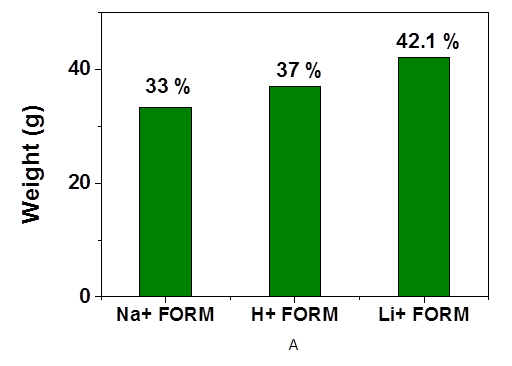
Recent Publications
[1] Su L, Darling R M, Gallager K G, Xie W, Thelen J L, Badel A F, Barton J L, Cheng K J, Balsara N P, Moore J S, Brushett F R (2016) An Investigation of the Ionic Conductivity and Species Crossover of Lithiated Nafion 117 in Nonaqueous Electrolytes. Journal of The Electrochemical Society 163(1): A5253-A5262
[2] Huang Q, Yang J, Ng C B, Jia C, Wang Q (2016) A redox flow lithium battery based on the redox targeting reactions between LiFePO4 and iodide. Energy & Environmental Science 9: 917-921
References
- Semiz L, Abdullayeva N, Sankir M (2018) Nanoporous Pt and Ru catalysts by chemical dealloying of Pt-Al and Ru-Al alloys for ultrafast hydrogen generation. Journal of Alloys and Compounds 744: 110-115.
- Serin R B, Abdullayeva N, Sankir M (2017) Dealloyed Ruthenium Film Catalysts for Hydrogen Generation from Chemical Hydrides. Materials 10(7): 738
- Abdullayeva N, Sankir M (2017) Influence of Electrical and Ionic Conductivities of Organic Electronic Ion Pump on Acetylcholine Exchange Performance. Materials 10(6): 586
- Akay T E, Abdullayeva N, Sankir M, Sankir N D (2016) On-Board Hydrogen Powered Proton Exchange Membrane Fuel Cells. ECS Transactions 75(14):511-513
- Sankir M, Semiz L, Sankir N D (2015) Catalyst free Hydrogen generation from directly disulfonated poly(arylene ether sulfone) copolymer Membranes. Journal of Membrane Science 496
Fatima Al Hameli
Khalifa University, UAE
Title: Fabrication of self-healing coating for withstanding desert based climate conditions

Biography:
Fatima Al Hameli has completed her graduation from Petroleum Institute, Abu Dhabi UAE with a Bachelor’s degree in Chemical Engineering in 2012. She has worked as a Senior Lab Technician for 3 years in the Microscopy Department of Borouge Ptv. Ltd. Innovation Center, which focused on developing new polymeric material for the market. Currently she is pursuing a Master’s degree in Khalifa University (Masdar Institute branch) in Materials Science and Engineering Department.
Abstract:
Solar energy is one of the most readily accessible sources of renewable energy that may be utilized in the United Arab Emirates. Yet at the same time the UAE has one of the most severe weather conditions as it has a harsh desert climate with high amounts of dust, and temperatures may reach up to 50 °C in the summer. Sand and tiny pebbles accumulate on solar panels forming small scratches on the coating surface resulting in reduction of its mechanical and optical properties, therefore reducing the potential maximum energy output. A proposed solution is the application of an epoxy coating with self-healing properties. Self-healing materials are commonly classified as either autonomic or non-autonomic materials. To benefit from both approaches this project will aim at utilizing both capsule based and intrinsic self-healing. The project also aims at utilizing the high temperatures of the UAE to act as the external stimulus to activate the intrinsic self-healing. The proposed self-healing coating is achieved by adding cellulose acetate butyrate (CAB) as the intrinsic healing agent and using halloysite nanotubes (HNT) to sequester healing agents as the capsule based approach. Various concentrations of CAB in epoxy are tested to obtain the best concentration for complete healing. Multiple healing temperature and time are also tested to obtain the optimum healing conditions. Samples were tested in outdoor conditions to study the effect of the weather and dust on the samples. Based on thermal and mechanical tests for complete healing of the material the optimum composition is an epoxy composite with 3 vol% CAB and 1 vol% HNT and the optimum healing temperature is 110 °C. Outdoor testing was carried out for three months during winter until the samples failed due to delamination. The addition of CAB provided improvement to the epoxy material to withstand weather conditions.
Image
Figure-1: Biweekly pictures of outdoor samples after washing and drying.
References
- D Y Wu, S Meure and D Solomon (2008) Self-healing polymeric materials: A review of recent developments. Progress in Polymer Science; 33: 479-522.
- S A Hayes, F R Jones, K Marshiya and W Zhang (2007) A self-healing thermosetting composite material. Composites Part A: Applied Science and Manufacturing; 38: 1116-1120.
- V Amendola and M Meneghetti (2009) Self-healing at the nanoscale. Nanoscale; 1: 74-88.
- B J Blaiszik, S L B Kramer, S C Olugebefola, J S Moore, N R Sottos and S R White (2010) Self-Healing Polymers and Composites. Annual Review of Materials Research; 40: 179-211.
- V K Thakur and M R Kessler (2015) Self-healing polymer nanocomposite materials: A review. Polymer; 69: 369-383.
Nujood Saeed Ali AlShehhi
Khalifa University, UAE
Title: Fabrication of antireflection and anti-soiling coatings for desert based solar panels

Biography:
Nujood Saeed Ali AlShehhi is currently pursuing her Master’s graduation in Khalifa University (Masdar Institute branch) and working on her Master’s degree in Materials Science and Engineering. Her research focus is on developing a polymer coating material with anti-reflective and anti-soiling properties as part of the project of a super coating.
Abstract:
This research paper focuses on the fabrication of antireflection and anti-soiling polymer composite by means of spray coating, which can be applied for solar panels. Due to the frequent sandstorms within the region dust accumulates on the panels reducing their efficiency in the absorption of solar radiation and because of scarcity of water sources in the Middle East in general the frequent cleaning consumes a lot of money and water. The objective is to fabricate and develop a coating for solar panels with anti-soiling and anti-reflection characteristics. The composite material chosen is the mineral material halloysite nanotube (HNTs). HNTs are chemically non-toxic and can be found in large amounts at low prices. The proposed method involves spray coating a polymer composite followed by plasma etching the surface to generate the necessary roughness. The first step is to etch the surface by exposing the samples to varying types of plasma with certain condition, varying time and concentration to obtain a rough surface and to make the etched surface suitable for the air refractive index. The second step is functionalization of the etched surface by CF4 plasma surface treatment. The Scanning Electron Microscope image shows how the different types of etching can affect the surface roughness, how HNTs are exposed to enhance the light transmission and to reduce/increase the wettability between the surface and the contact angle to achieve anti-reflection and self-cleaning properties. Optical and surface properties are further studied using spectroscopy and goniometer testing. From the results the optimum HNT concentration is 20 wt.% and the optimum etching conditions are etching with CF4 gas at 2 Pa and high power for 10 minutes. Finally, the spray coating can be developed with multi-characterization, long stability and low-cost coating that can easily be scaled up and applied onto current solar cells.
Peyman Akbari
Iran Polymer and Petrochemical Institute, Iran
Title: Synthesis of PEG-PLA diol as a new soft segment for biodegradable Urethane products
Biography:
Abstract:
Polyurethanes (PUs) are one of the vastly studied synthetic polymers in tissue engineering applications due to their diverse compositions and tunable physiochemical properties. A series of novel poly ethylene glycol/poly lactic acid (PEG-PLA) diols are synthesized. The success of synthesis and the structure of the block copolymers are demonstrated by FT-IR and H NMR analyses. The aim of this study is to develop a series of diols as soft segment for biodegradable urethane products. Making alteration to PEG:PLA ratio results in different degradation rates and mechanical properties of the urethane products. Briefly, PEG was reacted with lactic acid through a ring-opening polymerization using Sn(Oct)2 as catalyst at 180 ℃ under a N2 atmosphere to obtain a PLA-PEG-PLA block copolymer. The produced polymer was then precipitated successively in n-hexane/ethyl acetate solution. It shows the FT-IR spectra of PEG, PLA and PEG-PLA product. The characteristic absorption at 1753 cm-1 (C=O stretching) is observed, demonstrating the formation of ester linkage connecting PEG-PLA components. 1369 cm−1, 1456 cm−1 are respectively attributed to methyl and deformation vibration of C-H. The absorption peak at 2882 cm-1 indicates the presence of the alkyl C-H (stretching) bond in PEG spectra which agrees with the same peak in the PEG-PLA spectra. In conclusion, PEG-PLA block copolymers were prepared successfully. A series of PEG-PLA block copolymers were synthesized by ring opening polymerization of lactic acid and poly ethylene glycol. Copolymers were characterized by nuclear magnetic resonance (NMR) and infrared spectroscopy (IR), which confirmed that those were synthesized successfully. This synthetic diol can be used as soft segment for degradable polyurethane products in tissue engineering.
Image
References
- Ro A J, Huanga S J and Weiss R A (2009) Synthesis and Properties of Random Poly(Lactic Acid)-Based Ionomers. Polymer; 50: 1134-1143.
- Byuna Y, Rodriguezb K and Han J H (2015) Improved Thermal Stability of Polylactic Acid (PLA) Composite Film via PLA-β-Cyclodextrin-Inclusion Complex Systems. International Journal of Biological Macromolecules; 81: 591- 598.
- Diao J P, Wang H X, Chang N N, et al. (2015) PEG-PLA Nanoparticles Facilitate siRNA Knockdown in Adult Zebrafish Heart. Developmental Biology; 406: 196-202.
- Piorkowska E, Kulinski Z, Galeski A, et al. (2006) Plasticization of Semicrystalline Poly(L-Lactide) with Poly (Propylene Glycol). Polymer; 47: 7178-7188.
- Reddy M M, Vivekanandhana S and Misra M (2013) Biobased Plastics and Bionanocomposites: Current Status and Future Opportunities. Progress in Polymer Science; 38: 1653-1689.
Hadi Firoozi
Islamic Azad University, Iran
Title: Study of surface characteristics of biomaterials used for medical devices and biosensors

Biography:
Hadi Firoozi is a last year MSc student in Materials Science at Science and Research Branch at Islamic Azad University. His research experiences include surface characterization and modification materials as well as different methods of surface coating including chemical vapor deposition (CVD) and physical vapor deposition (PVD).
Abstract:
Introduction
The geometry, structural properties and importantly surface features of implants play an important role on their biocompatibility and post implantation induced foreign body response [1]. The formation of fibrotic tissue in the surrounding of implants can define their fate and potentially hinder the performance of medical devices by creating diffusional barriers for oxygen and nutrient transport [2-4]. The reduced transport dynamics can then lead to creation of hypoxic conditions affecting tissue function and performance of the implants [5,6]. It is therefore crucial to study the surface features and characteristics of biomaterials prior to implantation. In this study, porous pure titanium and stainless steel (304), two widely used prosthetics implants due to their proper elastic modulus, biocompatibility and corrosion resistant, and the ability to control their surface features are studied [7-11]. This investigation focuses on surface characteristics of these materials which are mostly used on outer surfaces of medical devices and as orthopedic implants.
Experimental procedure
Scanning electron microscopy (SEM) (performed by Quanta 600, FEI company) shows significant variability in the surface characteristic of all studied implant materials. The pore size and geometry is analyzed using MATLAB to map the pore distribution.
Results and discussion
The difference in pore size, pore shape and distribution of the studied stainless steel and pure titanium is shown in Figure 1. Their different porous structures can cause differences in induced foreign body response and ultimately the function of the medical devices and implants using them as outer surfaces.
Image:
A)
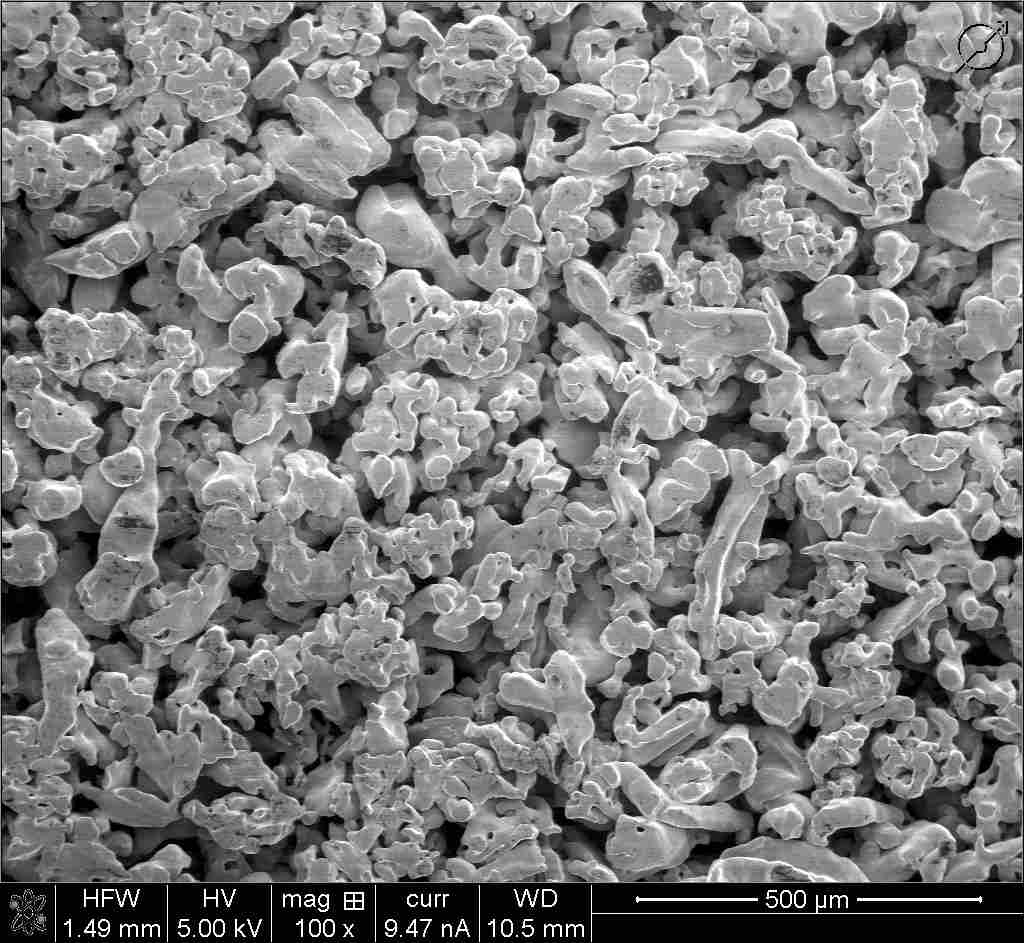
B)
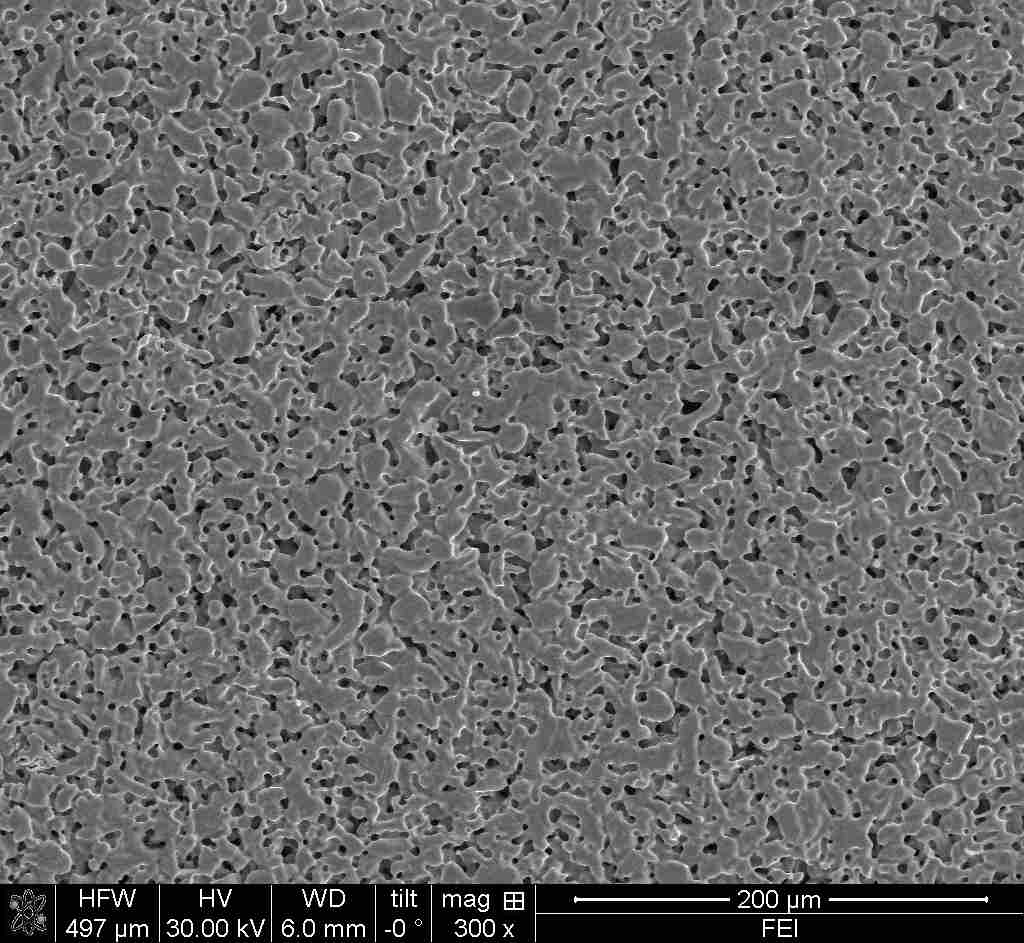
Fig. 1. Scanning electron microscopy (SEM) images of (A) porous stainless steel 314, (B) porous pure titanium.
Our image analysis shows a lower variety in pore size distribution and shape in stainless steel as compared to titanium. This might be because of higher ability to control the surface features for this material. These surface characteristics are important for medical devices because the induced fibrosis can change the diffusional characteristics, moreover the are crucially important for orthopedic implants as well, since the quality of the bone formed is greatly influenced by the properties of the implants. This investigation can be further extended to in vivo studies and histological analysis, results can then show how changes in pore size distribution affects the foreign body response.
Conclusion
Our analysis matched with an extensive literature study on foreign body response of different materials and their surface characteristics confirms the importance of our investigation on selection of biomaterials with appropriate surface features based on their final use in medical devices or implant applications. The stainless steel has shown a higher uniformity in pore size distribution. Following studies will discuss the effects of pore distribution on mechanical and diffusional characteristics of these materials.
References
- Anderson JM, Rodriguez A, Chang DT. Foreign body reaction to biomaterials. InSeminars in immunology 2008 Apr 1 (Vol. 20, No. 2, pp. 86-100). Academic Press.
- Tang L, Thevenot P, Hu W. Surface chemistry influences implant biocompatibility. Current topics in medicinal chemistry. 2008 Mar 1;8(4):270-80.
- Najdahmadi A, Lakey JR, Botvinick E. Diffusion coefficient of alginate microcapsules used in pancreatic islet transplantation, a method to cure type 1 diabetes. InNanoscale Imaging, Sensing, and Actuation for Biomedical Applications XV 2018 Feb 20 (Vol. 10506, p. 105061D). International Society for Optics and Photonics.
- Kummerfeld G, Krishnan R, Najdahmadi A, Botvinick E, Lakey JRT. Alginate composition and temperature influence microcapsule permeability. Royan international twin congress 11th congress on stem cell biology and technology. 2015/9;17(1):19–20.
- Higgins DM, Basaraba RJ, Hohnbaum AC, Lee EJ, Grainger DW, Gonzalez-Juarrero M. Localized immunosuppressive environment in the foreign body response to implanted biomaterials. The American journal of pathology. 2009 Jul 1;175(1):161-70.
- Najdahmadi A, Gurlin RE, Weidling J, White S, Shergill B, Lakey JR, Botvinick E. Non invasive study of oxygen tension and vascularization in subcutaneously implanted medical devices. InProc. SPIE 2018 (Vol. 10488, p. 1048847).
- Buser D, Broggini N, Wieland M, Schenk RK, Denzer AJ, Cochran DL, Hoffmann B, Lussi A, Steinemann SG. Enhanced bone apposition to a chemically modified SLA titanium surface. Journal of dental research. 2004 Jul;83(7):529-33.
- Schwarz F, Herten M, Sager M, Wieland M, Dard M, Becker J. Bone regeneration in dehiscenceâ€type defects at chemically modified (SLActive®) and conventional SLA titanium implants: a pilot study in dogs. Journal of clinical periodontology. 2007 Jan 1;34(1):78-86.
- Gotman I. Characteristics of metals used in implants. Journal of endourology. 1997 Dec;11(6):383-9.
- Najdahmadi A, Zarei-Hanzaki A, Farghadani E. Mechanical properties enhancement in Ti–29Nb–13Ta–4.6 Zr alloy via heat treatment with no detrimental effect on its biocompatibility. Materials & Design (1980-2015). 2014 Feb 1;54:786-91.
- Najdahmadi A, Zarei-Hanzaki A, Farghadani. Microstructural evaluation and mechanical properties of solution treated biomedical TNTZ alloy. International conference of metallurgical engineering society and foundry men’s society 1622-IMES-CONGR-FULL [Internet]. 2012 Oct; Available from: http://dx.doi.org/10.13140/RG.2.2.21846.96325
Takin Ghavimi
University of Tehran, Iran
Title: Fabrication of new LSCF infiltrated BSCF material to increase electrochemical performance of fuel cells

Biography:
Mr Takin Ghavimi graduated with his MSc in Materials Science from University of Tehran. His MSc research at university of Tehran focused on synthesis of novel electrode materials used in solid oxide fuels cell technology. Mr Ghavimi’s recent work aims to increase the performance and functionality of solid oxide fuel cells by development of advanced cathode materials.
Abstract:
Introduction
A solid oxide fuel cell (SOFC) is an electrochemical conversion device that produces electricity directly from fuels. These fuel cells are comprised of ceramic electrolytes that can provide high efficiency in performance, fuel flexibility and overall low cost of the system [1]. The main disadvantage of these systems is the high operation temperature, which can result in (1) formation of an insulating layer, caused by reaction between electrode and electrolyte materials, (2) the necessity of using high cost interconnecting materials such as LsCrO3 and (3) possibility of crack formation caused by thermal coefficient mismatch between the electrode and electrolyte materials [2]. As is shown in literature, material characteristics in general can be modified using different thermal and environmental treatments and before and after fabrication and synthesis [3-10]. In our work, we investigate modification methods to reduce the operating temperature of SOFCs without sacrificing the system performance through fabrication of a new solution infiltrated Ba0.5Sr0.5Co0.8Fe0.2O3-δ (BSCF) cathode, employing the two most effective cathode materials BSCF (Ba0.5Sr0.5Co0.8Fe0.2O3-δ) and LSCF (La0.6Sr0.4Co0.2Fe0.8O3-δ).
Methods and materials
Ceramics were synthesized using co-precipitation method at precipitation pH of at least 8 and a calcination temperature of 1000°C. The structure of synthesized ceramics is studied using X-ray diffraction (Philips PW-1730).
Results and discussion
BSCF has the advantage of high ionic conductivity due to its high concentration of oxygen vacancies, enabling it to easily permit the diffusion of oxygen ions while LSCF is known to possess significantly higher electronic conductivity as well as better performance at operating temperatures of bellow 750 ºC [11,12]. We aim to achieve both characteristics of the individual components. To produce the infiltrated BSCF, we first used our developed method of co-precipitation synthesis, which was followed by structure analysis using X-ray Diffraction (XRD). The synthesized powders were then used to fabricate electrochemical half cells. These cells were infiltrated with a nitrate solution of LSCF and calcined at 1000 ºC for 5 hours to permit the LSCF to crystalize. The electrochemical performance of the half cells was then evaluated. Our results show the cells with infiltrated BSCF electrode possess higher electronic conductivity than those with pure BSCF electrodes.
Image:
A)
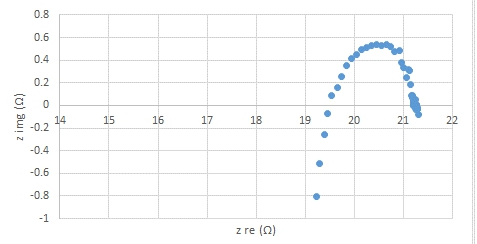
B)
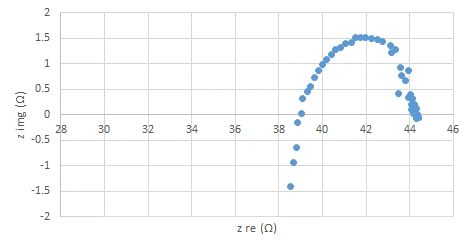
Fig.1. Impedcance spectra of (A) BSCF infiltrated LSCF and (B) LSCF at 600 ºC shows lower resistance and therofore higher electonic conductivity in BSCF/LSCF
Conclusion
The results of this investigation can be used in fabrication of fuel cells capable of operating in lower temperatures, which can reduce the overall costs of obtaining electricity and increase the performance efficiency.
References:
- Fergus J, Hui R, Li X, Wilkinson DP, Zhang J. Solid Oxide Fuel Cells: Materials Properties and Performance. CRC Press; 2008. 298 p.
- Singhal SC, Kendall K. High-temperature Solid Oxide Fuel Cells: Fundamentals, Design and Applications. Elsevier; 2003. 406 p.
- Chang J-K, Chen Y-L, Tsai W-T. Effect of heat treatment on material characteristics and pseudo-capacitive properties of manganese oxide prepared by anodic deposition. J Power Sources. 2004;135(1-2):344–53.
4. Najdahmadi A, Zarei-Hanzaki A, Farghadani E. Mechanical properties enhancement in Ti–29Nb–13Ta–4.6Zr alloy via heat treatment with no detrimental effect on its biocompatibility. Mater Des. 2014;54:786–91.
5.Kokubo T, Miyaji F, Kim H-M, Nakamura T. Spontaneous Formation of Bonelike Apatite Layer on Chemically Treated Titanium Metals. J Am Ceram Soc. 1996;79(4):1127–9.
6.Najdahmadi A, Zarei-Hanzaki A, Farghadani. Microstructural evaluation and mechanical properties of solution treated biomedical TNTZ alloy. International conference of metallurgical engineering society and foundry men’s society 1622-IMES-CONGR-FULL [Internet]. 2012 Oct; Available from: http://dx.doi.org/10.13140/RG.2.2.21846.96325
7. KochmaÅ„ska A, Garbiak M. High-Temperature Diffusion Barrier for Ni-Cr Cast Steel. Diffus Defect Data Pt A. 2011;312-315:595–600.
8. Najdahmadi A, Lakey JR, Botvinick E. Diffusion coefficient of alginate microcapsules used in pancreatic islet transplantation, a method to cure type 1 diabetes. InNanoscale Imaging, Sensing, and Actuation for Biomedical Applications XV 2018 Feb 20 (Vol. 10506, p. 105061D). International Society for Optics and Photonics
9. Wei C, Srivastava D, Cho K. Thermal Expansion and Diffusion Coefficients of Carbon Nanotube-Polymer Composites. Nano Lett. 2002;2(6):647–50.
10. Kummerfeld G, Krishnan R, Najdahmadi A, Botvinick E, Lakey JRT. Alginate composition and temperature influence microcapsule permeability. Royan international twin congress 11th congress on stem cell biology and technology. 2015/9;17(1):19–20.
11.Li S, Zhe L, Huang X, Wei B, Su W. Thermal, electrical, and electrochemical properties of Lanthanum-doped Ba0.5Sr0.5 Co0.8Fe0.2O3–δ. J Phys Chem Solids. 2007;68(9):1707–12.
12. Tsipis EV, Kharton VV. Electrode materials and reaction mechanisms in solid oxide fuel cells: a brief review. J Solid State Electrochem. 2008;12(11):1367–91.
Takin Ghavimi
University of Tehran, Iran
Title: Synthesis and stabilization of highly conductive cubic SrCoO3 to increase solid oxide fuel cell efficiency

Biography:
Mr Takin Ghavimi graduated with his MSc in Materials Science from University of Tehran. His MSc research at university of Tehran focused on synthesis of novel electrode materials used in solid oxide fuels cell technology. Mr Ghavimi’s recent work aims to increase the performance and functionality of solid oxide fuel cells by development of advanced cathode materials.
Abstract:
Introduction: SrCoO3 is an important perovskite parent compound used for development of a variety of functional materials. As is shown in literature structural properties of different materials can change in different environments, operation temperatures and oxygen partial pressures [1-8]. Additionally, in ceramics such as SrCoO3 thermal history and synthesis process can be important factors in displaying multiple crystal structures [9]. Replacement of 20% of cobalt with iron is shown to improve the electric conductivity of this material SrCoO3 [10]. The perovskite SrCo0.8Fe0.2O3 can display mixed ionic and electronic conducting properties (MIEC) which makes this oxide useful for a variety of applications, including fabrication of oxygen separation membranes, combustion catalysts and importantly cathode/anode materials for solid oxide fuel cells (SOFC), a device that can produce electricity directly from fuels such as hydrogen and methane[11,12]. Important to our research is the cubic structure of this material which possesses the highest electronic and oxygen ionic conductivity with a reported total electric conductivity of 160 S.cm-1 at 950°C [13]. It is shown that substitution of various elements in the A and B site of this material can increase the stability of its cubic crystal structure. In this study, we have adopted a strategy of element substitution in the A site of the SrCo0.8Fe0.2O3 perovskite to stabilize its cubic crystal structure, which is believed to result in an improvement of the electric conductivity of this material.
Methods and materials: Ceramics were synthesized using co-precipitation method. the precipitation pH of at least 8 is required for the precipitation to be completed. The precipitates are subsequently calcined at a temperature of 1000°C to achieve the perovskite. The structure of synthesized ceramics is then studied using X-ray diffraction (Philips PW-1730) and scanning electron microscopy (TESCAN-MIRA3)
Results and Discussion: SrCo0.8Fe0.2O3 (SCF) and A site barium doped SCF were synthesized by a novel co-precipitation method to examine the effect of barium substitution on stabilization of the SCF cubic lattice. After synthesis, the obtained crystal structures were analyzed to evaluate the success of our co-precipitation method. Our results show that by replacement of 50% strontium with barium, the hexagonal structure of SCF at room temperature was changed to cubic (Fig. 1A & Fig.1B). Modification of the temperature and environment of synthesis further increased the success in achieving a pure cubic perovskite phase . Figure 2 shows and SEM image of the cubical perovskite structure.
Image:
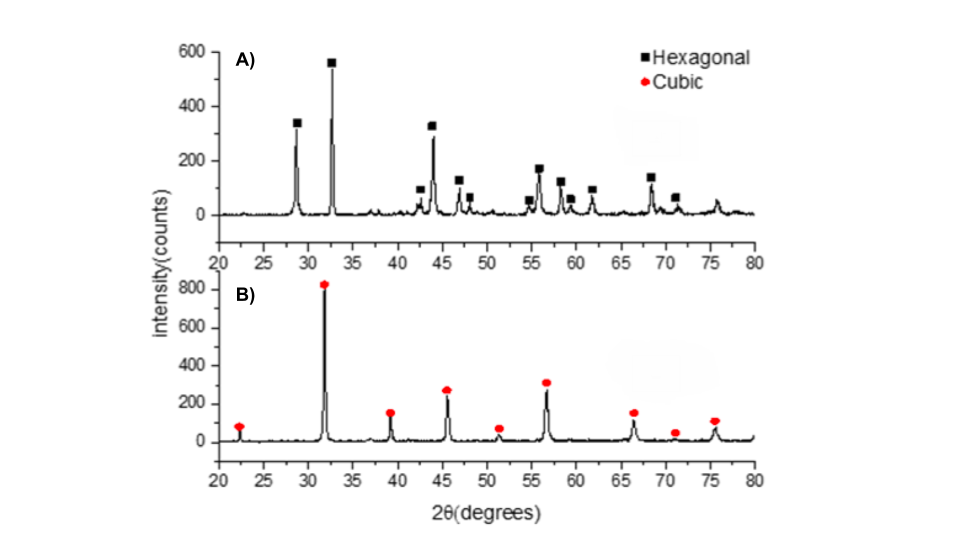
Fig. 1. XRD image of (1.A) hexagonal SrCo0.8Fe0.2O3 and cubical Ba doped SrCo0.8Fe0.2O3
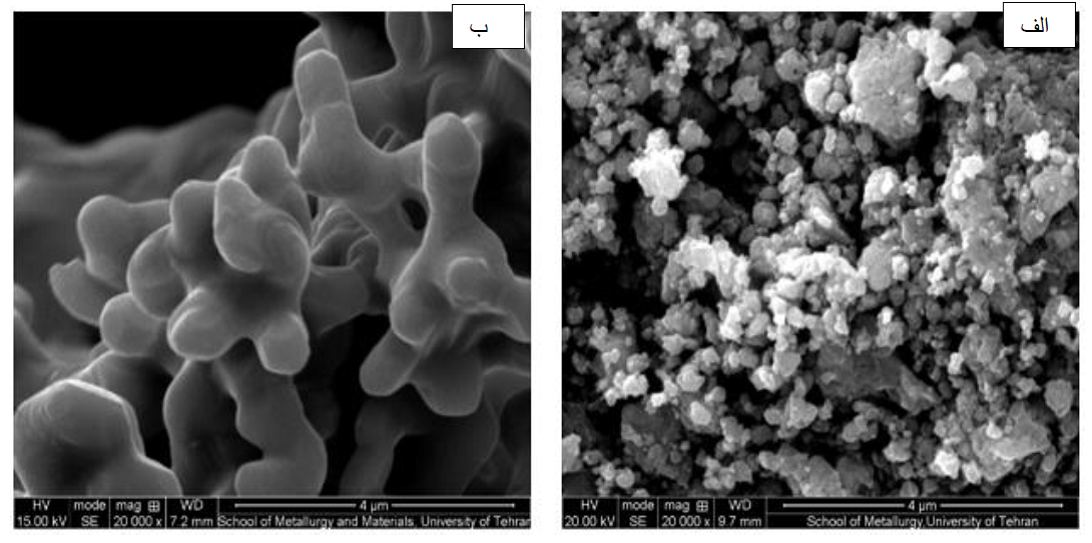
Fig. 2. Scanning electron microscopy of cubical Ba doped SrCo0.8Fe0.2O3.
Conclusion: Our strategy can result in a more stable cubic structure of SCF perovskite oxide. This new perovskite with the chemical formula Ba0.5SrCo0.8Fe0.2O3 can be used in fabrication of device compartments with higher electronic and oxygen ionic conductivity such as new class of cathodes for SOFCs. These new fuel cell devices can potentially increase the efficiency and performance of solid oxide fuel cells and eventually result in significantly lower costs the production electricity.
References:
- Chang J-K, Chen Y-L, Tsai W-T. Effect of heat treatment on material characteristics and pseudo-capacitive properties of manganese oxide prepared by anodic deposition. J Power Sources. 2004;135(1-2):344–53.
2. Najdahmadi A, Zarei-Hanzaki A, Farghadani E. Mechanical properties enhancement in Ti–29Nb–13Ta–4.6Zr alloy via heat treatment with no detrimental effect on its biocompatibility. Mater Des. 2014;54:786–91.
3. Kokubo T, Miyaji F, Kim H-M, Nakamura T. Spontaneous Formation of Bonelike Apatite Layer on Chemically Treated Titanium Metals. J Am Ceram Soc. 1996;79(4):1127–9.
4. Najdahmadi A, Zarei-Hanzaki A, Farghadani. Microstructural evaluation and mechanical properties of solution treated biomedical TNTZ alloy. International conference of metallurgical engineering society and foundry men’s society 1622-IMES-CONGR-FULL [Internet]. 2012 Oct; Available from: http://dx.doi.org/10.13140/RG.2.2.21846.96325
5. KochmaÅ„ska A, Garbiak M. High-Temperature Diffusion Barrier for Ni-Cr Cast Steel. Diffus Defect Data Pt A. 2011;312-315:595–600.
6. Najdahmadi A, Lakey JR, Botvinick E. Diffusion coefficient of alginate microcapsules used in pancreatic islet transplantation, a method to cure type 1 diabetes. InNanoscale Imaging, Sensing, and Actuation for Biomedical Applications XV 2018 Feb 20 (Vol. 10506, p. 105061D). International Society for Optics and Photonics
7. Wei C, Srivastava D, Cho K. Thermal Expansion and Diffusion Coefficients of Carbon Nanotube-Polymer Composites. Nano Lett. 2002;2(6):647–50.
8. Kummerfeld G, Krishnan R, Najdahmadi A, Botvinick E, Lakey JRT. Alginate composition and temperature influence microcapsule permeability. Royan international twin congress 11th congress on stem cell biology and technology. 2015/9;17(1):19–20.
9. Ito Y, Klie RF, Browning ND, Mazanec TJ. Atomic Resolution Analysis of the Defect Chemistry and Microdomain Structure of Brownmilleriteâ€Type Strontium Cobaltite. Journal of the American Ceramic Society. 2002 Apr 1;85(4):969-76
10. Teraoka Y, Nobunaga T, Okamoto K, Miura N, Yamazoe N. Influence of constituent metal cations in substituted LaCoO3 on mixed conductivity and oxygen permeability. Solid State Ionics. 1991 Nov 1;48(3-4):207-12.
11. Fergus J, Hui R, Li X, Wilkinson DP, Zhang J, editors. Solid oxide fuel cells: materials properties and performance. CRC press; 2016 Apr 19.
12. Qiu L, Lee TH, Liu LM, Yang YL, Jacobson AJ. Oxygen permeation studies of SrCo0. 8Fe0. 2O3− δ. Solid State Ionics. 1995 Mar 1;76(3-4):321-9.
13. Deng ZQ, Yang WS, Liu W, Chen CS. Relationship between transport properties and phase transformations in mixed-conducting oxides. Journal of Solid State Chemistry. 2006 Feb 1;179(2):362-9

